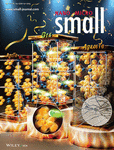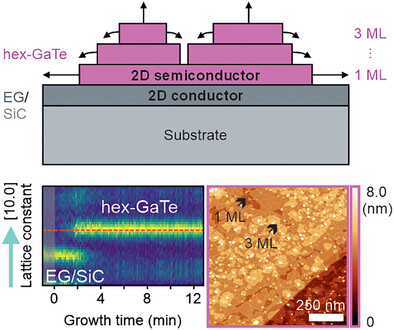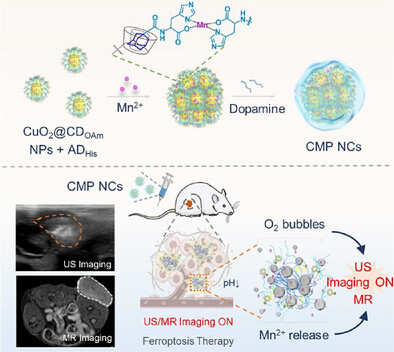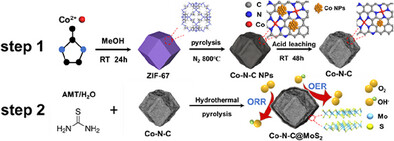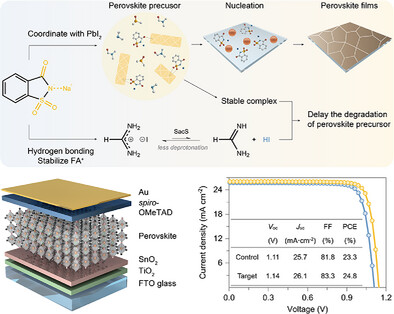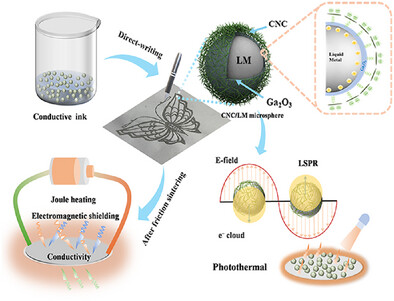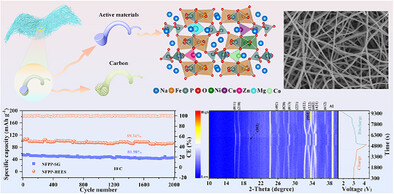Journal list menu
Export Citations
Download PDFs
Cover Picture
Modulating Solid-Solution Solubility to Enhance Thermoelectric Performance and Maintain Structural Stability in Phase-Transition Silver Chalcogenides (Small 24/2025)
- First Published: 19 June 2025
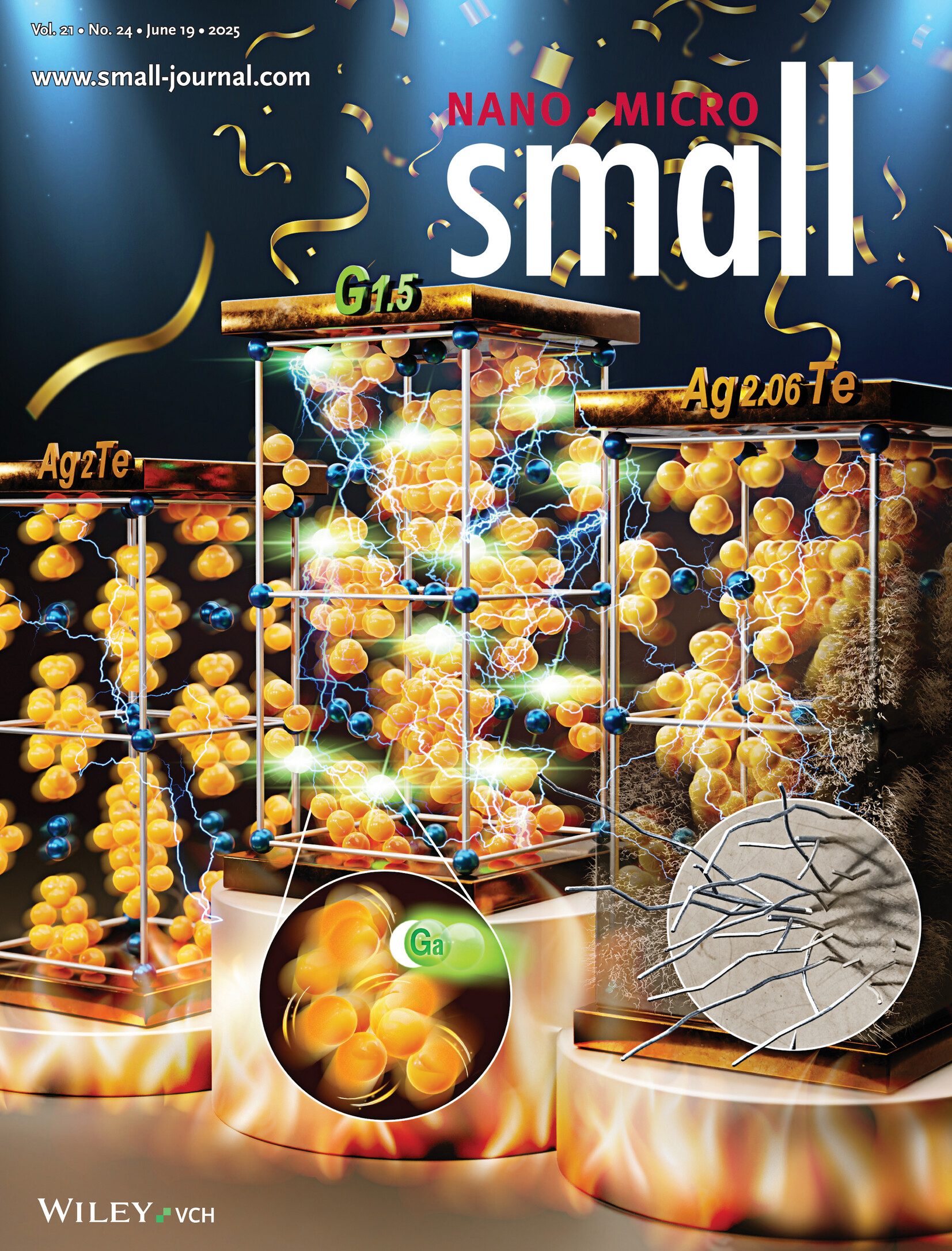
Silver Chalcogenides
In article number 2410583, Hsin-Jay Wu and co-workers uncover the mechanism of silver whisker growth and propose a method to inhibit it. By modulating the solubility of the silver solid solution through dilute Ga doping, the Ga-Ag2+xTe achieves improved thermoelectric performance, reaching a conversion efficiency of 2.3% with a ΔT of 300 K, and remains free of whiskers after high-temperature testing, resulting in a thermally stable, high-performance thermoelectric device.
Inside Front Cover
Infrared-Triggered Retinomorphic Artificial Synapse Electronic Device Containing Multi-Dimensional van der Waals Heterojunctions (Small 24/2025)
- First Published: 19 June 2025
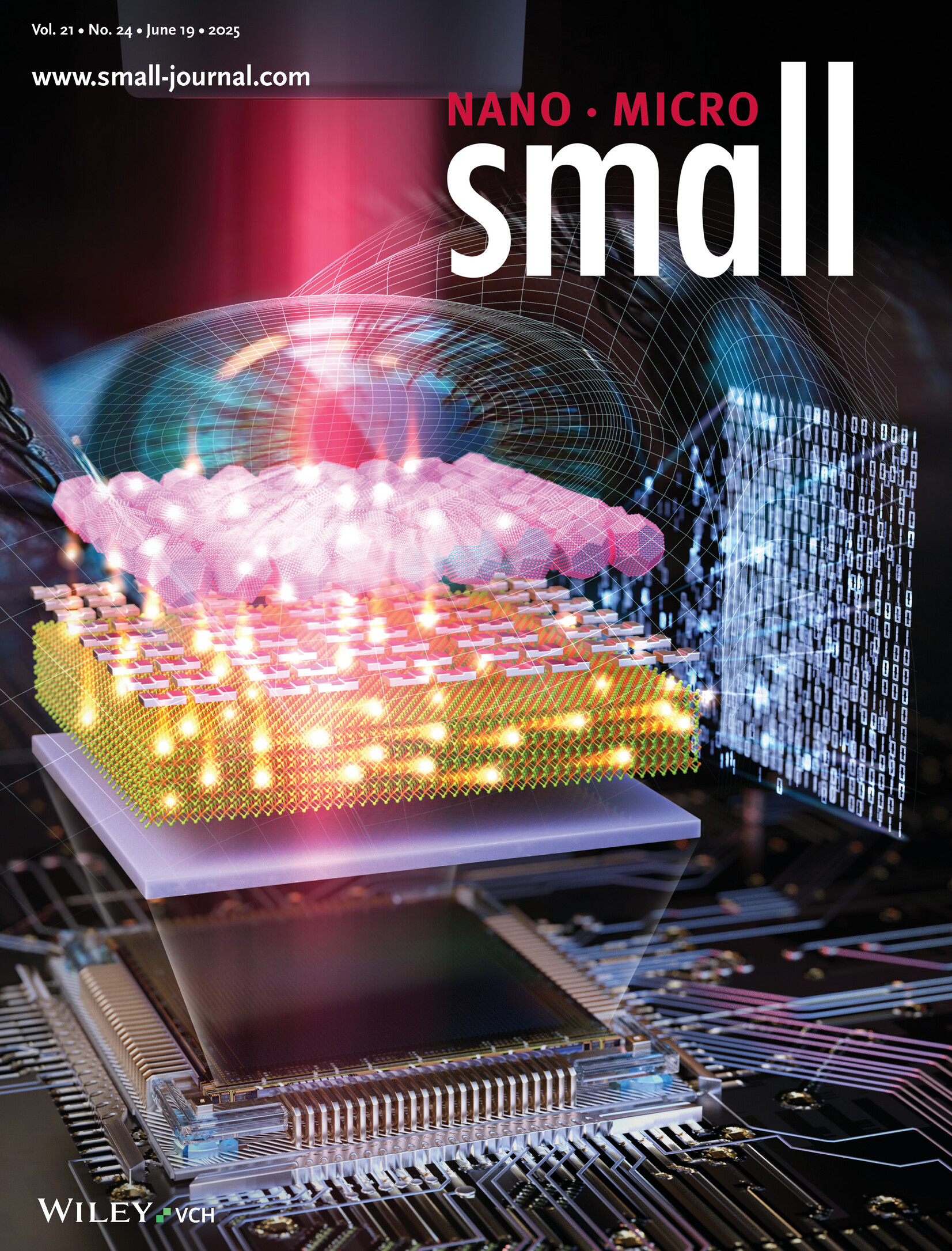
Retinomorphic Artificial Synapses
In article number 2410892, Nuri Oh, Jun Hong Park, and co-workers introduced a retinomorphic artificial synapse, inspiring the human retina, with multidimensional van der Waals heterojunction. InAs quantum dots are deposited on a WSe2 channel as photon receptors, facilitating efficient short-wavelength infrared (SWIR) detection. As a result, the device adapts to the SWIR signal and emulates biological synaptic properties with a superior image recognition rate, showing potential for machine vision.
Inside Back Cover
Ultraviolet-Resistant Flexible Perovskite Solar Cells with Enhanced Efficiency Through Attachable Nanophotonic Downshifting and Light Trapping (Small 24/2025)
- First Published: 19 June 2025
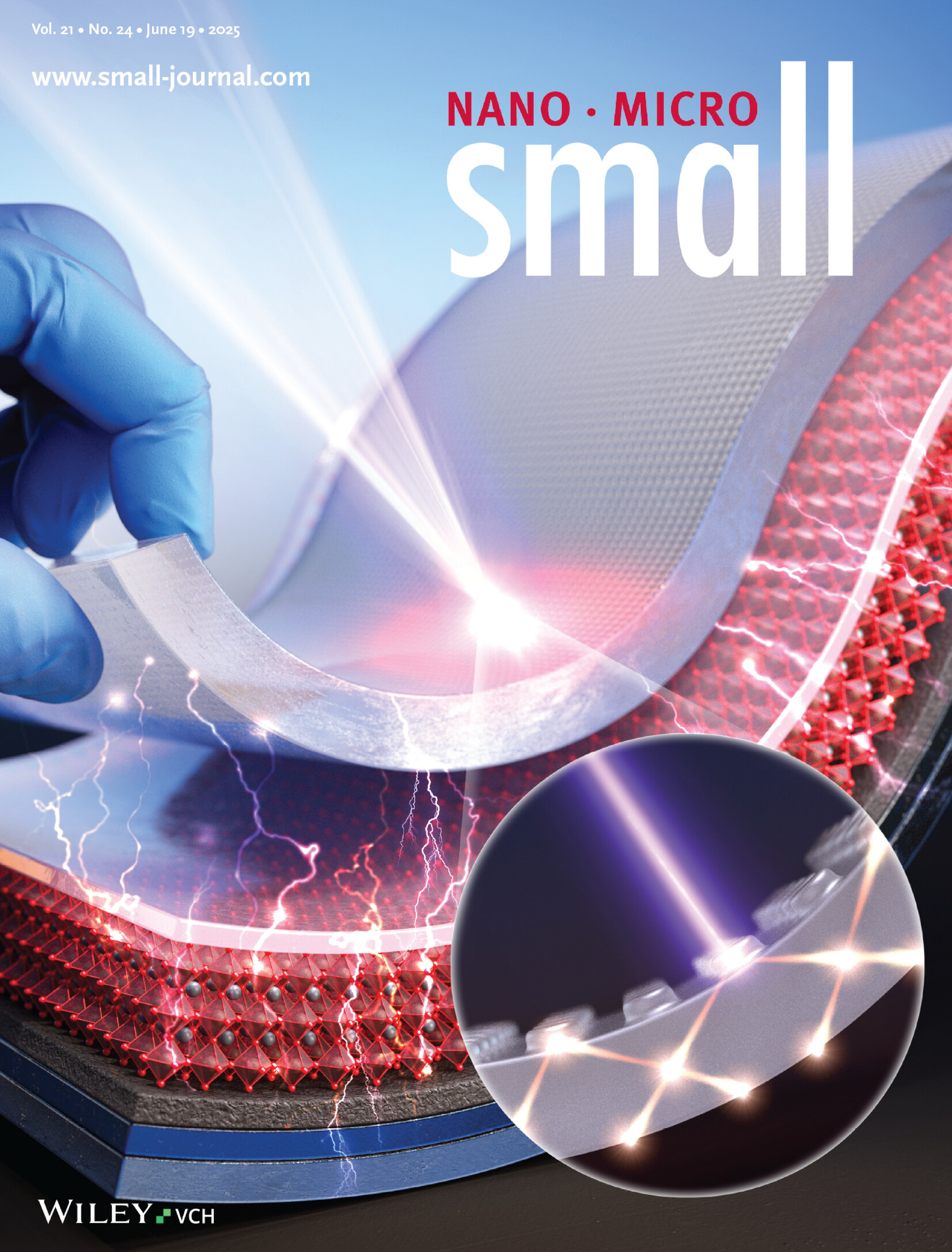
Perovskite Solar Cells
In article number 2501374, Seok Ho Cho, Sung-Min Lee, and co-workers present a strategy for UV-resistant, flexible, and high-performance perovskite solar cells using a colorless polyimide and a nanostructured luminescent sticker with a Eu-complex downshifter. Due to the combined effects of downshifting and synergistic light trapping, UV-resistant solar cells achieve an efficiency of 20.4%.
Back Cover
Molecularly Engineered Artificial Solid Electrolyte Interphase with Tailored Lithiophilicity and Solvent-Phobicity for Stable Lithium Metal Batteries (Small 24/2025)
- First Published: 19 June 2025
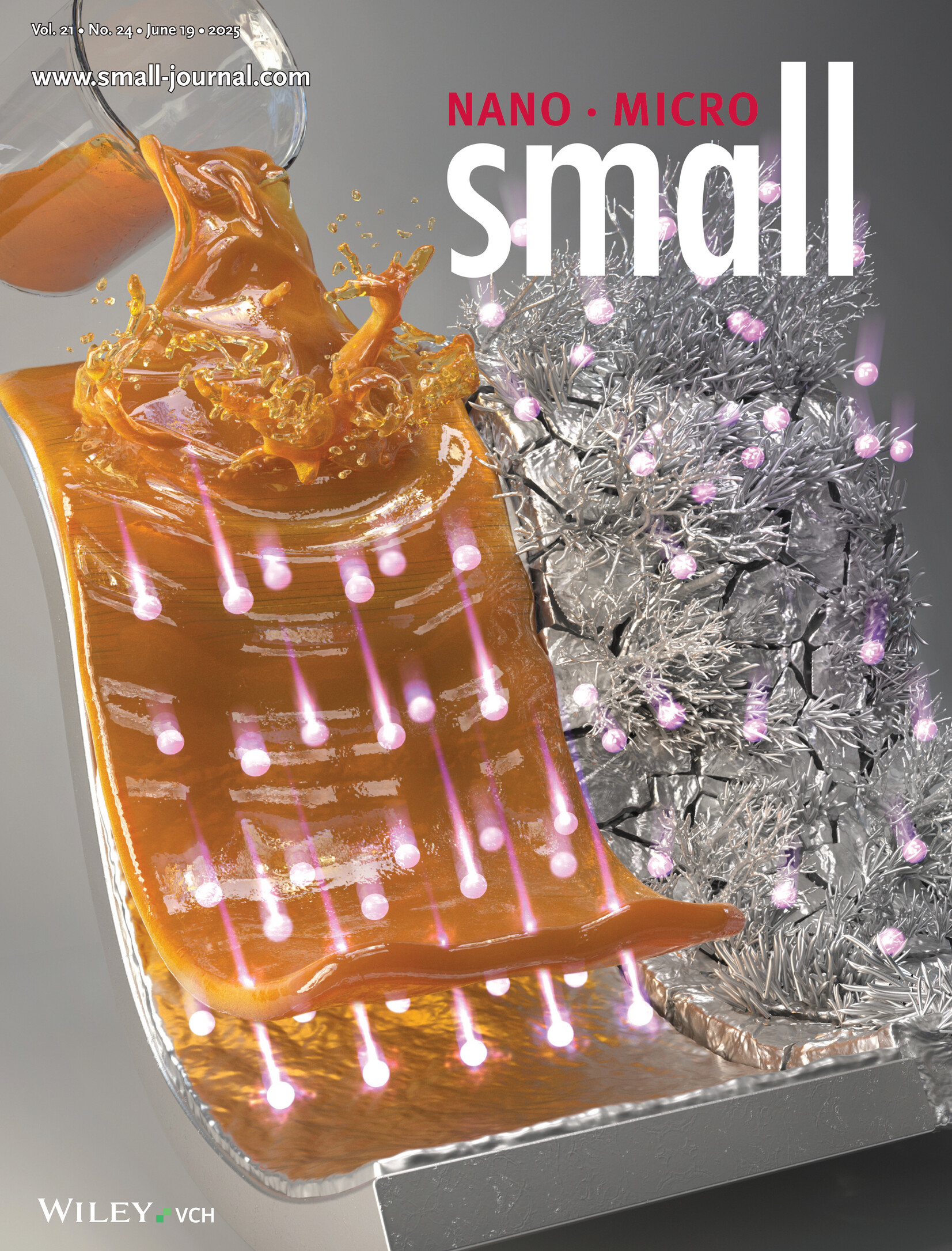
Lithium Metal Batteries
In article number 2411861, Jimin Shim and co-workers introduce a molecularly engineered artificial solid electrolyte interphase (SEI) with tailored lithiophilicity and solvent-phobicity to address the challenges of lithium metal anodes, including uncontrolled electrodeposition and irregular SEI formation. This study highlights that modulating the molecular characteristics and physical properties of SEIs enables dendrite-free, long-lasting lithium metal batteries.
Issue Information
Correction
Correction to “Ta4C3 Nanosheets as a Novel Therapeutic Platform for Photothermal-Driven ROS Scavenging and Immune Activation Against Antibiotic-Resistant Infections in Diabetic Wounds”
- First Published: 25 April 2025
Perspective
A Paradigm Shift: From Batch Processing to Flow Chemistry
- First Published: 02 May 2025
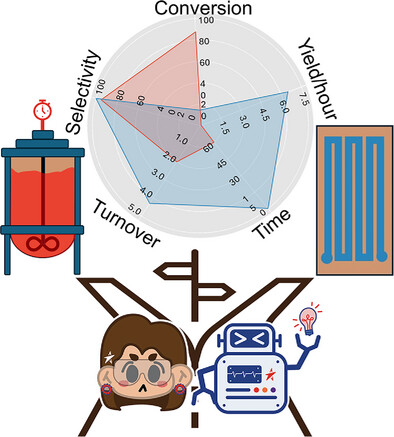
As automated flow reactors and optimization algorithms are becoming more affordable and accessible to wider research communities, now it has the option of integrating flow reaction setup much earlier during the research/discovery phase. In this perspective, parallels, differences, and challenges in optimizing batch and flow heterogeneous catalytic reactions will be presented with practical examples. Future directions for implementing computational optimization methods into flow optimization of sustainable “chemical looping” reactions will also be discussed.
Review
Construction of Biomimetic Nanochannel, Property Regulation, and Biomarker Detection
- First Published: 28 April 2025
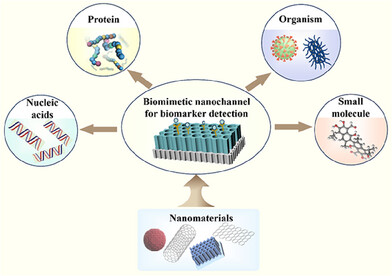
This paper reviews the controllable construction of functional nanochannels, performance modulation with demonstrating their great importance and wide interests. It outlines strategies for constructing and tailoring functional nanochannels and the emerging advances. The exceptional performance in detecting various biomarkers is highlighted, and future trends and challenges in this emerging field are discussed.
Multiscale Design of Array-Type Integrated Electrodes for Gas-Involving Electrocatalytic Reactions
- First Published: 02 May 2025
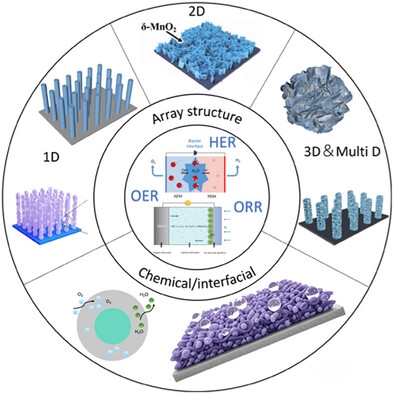
Gas-involving OER/HER/ORR processes are inevitably faced with sluggish intrinsic kinetics at large current conditions. Due to difficult mass transfer in multiphase conversion processes. As a promising solution, relevant design strategies of array-type integrated electrodes are systematically summarized from perspectives of macroscopic multidimensional and microscopic chemical/interfacial structure, together with composite strategies. Design rules as well as outlooks for mass transfer are also provided.
Ceramic–Polymer Composite Solid-State Electrolytes for Solid-State Lithium Metal Batteries: Mechanism, Strategy, and Prospect
- First Published: 02 May 2025
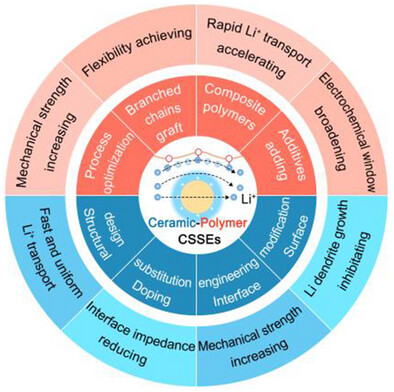
The mechanisms for internal/interfacial Li+ transport in ceramic–polymer composite solid-state electrolytes are discussed. Subsequently, the screening and modified strategies for polymer and ceramic active fillers including structural design, surface modification, and interface engineering, are summarized. Finally, the core ideas and future development of designs and feasible solutions are prospected.
Breaking Barriers in Oncology: Harnessing Sonodynamic Therapy for Enhanced Tumor Metabolism Regulation
- First Published: 02 May 2025
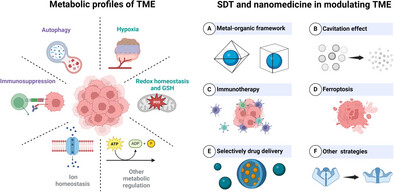
The objective of this review is to illustrate the specific metabolic profiles of tumor microenvironment (TME), and summarized the recent advances of sonodynamic therapy (SDT) on the regulation of tumor metabolism. It is hoped this review can provide valuable insights for future research, and promote the development and application of SDT-based antitumor therapy in future.
Challenges and Emerging Trends in Hydrogen Energy Industrialization: From Hydrogen Evolution Reaction to Storage, Transportation, and Utilization
- First Published: 13 May 2025
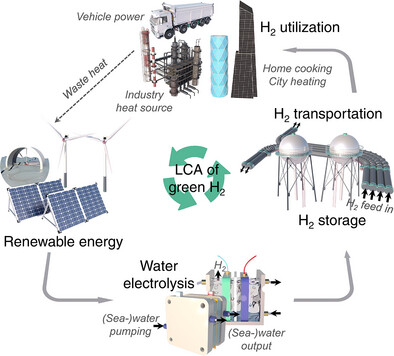
This review presents a comprehensive analysis of recent studies on green H2, covering key aspects including production, storage, transportation, utilization, and market potential. It is further complemented by life cycle assessments to validate the environmental benefits of utilizing renewable energy sources for green H2 generation. Altogether, this work aims to provide strategic insights to accelerate hydrogen energy industrialization.
Frontispiece
In Situ Unravelling NiOOH Species on Flower-Like NiFeCo LDH/Nb2CTx for Ameliorated Solar-Powered Bifunctional Electrocatalytic Benzyl Alcohol Oxidation Coupled with Hydrogen Evolution (Small 24/2025)
- First Published: 19 June 2025
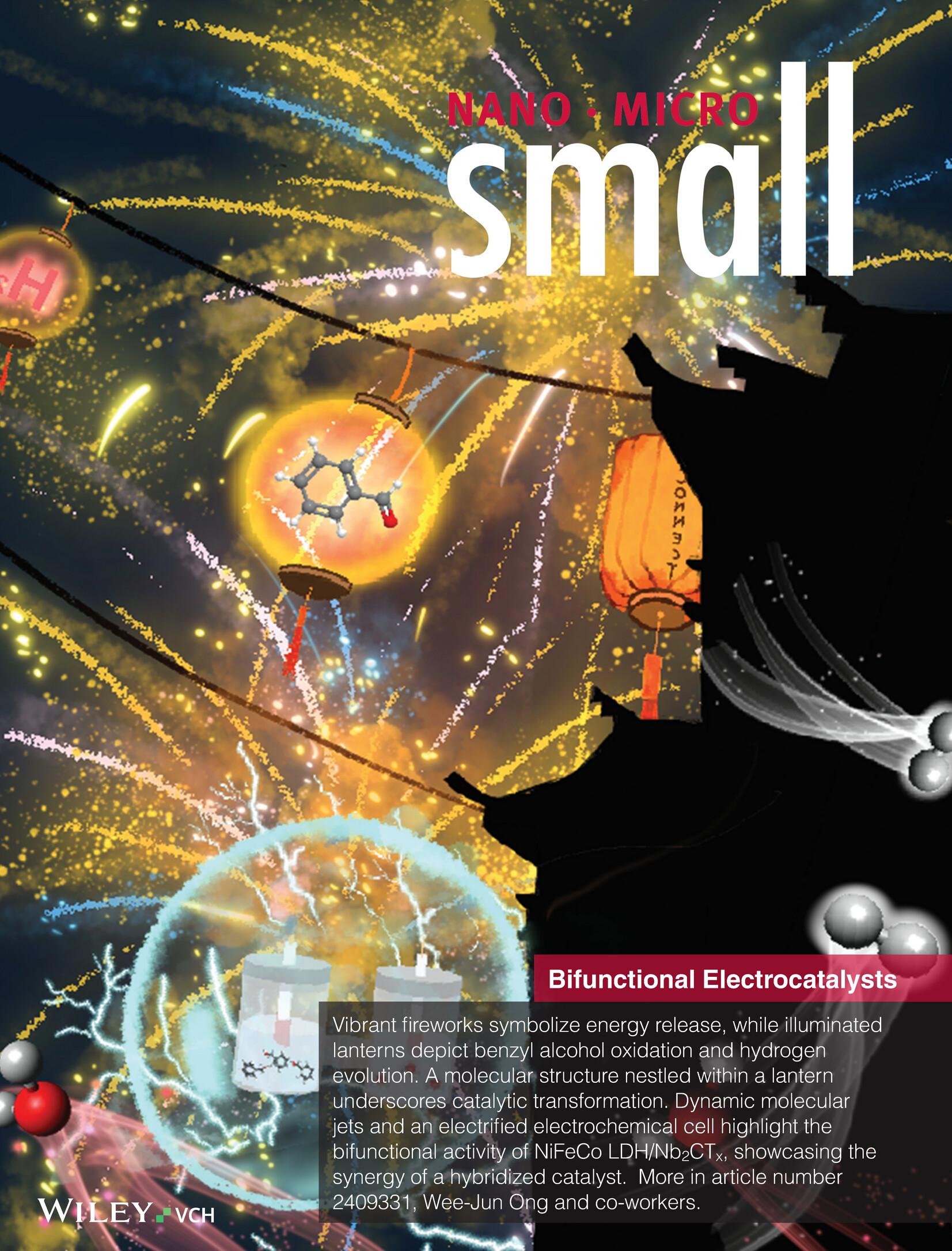
Bifunctional Electrocatalysts
Vibrant fireworks symbolize energy release, while illuminated lanterns depict benzyl alcohol oxidation and hydrogen evolution. A molecular structure nestled within a lantern underscores catalytic transformation. Dynamic molecular jets and an electrified electrochemical cell highlight the bifunctional activity of NiFeCo LDH/Nb2CTx, showcasing the synergy of a hybridized catalyst. More in article number 2409331, Wee-Jun Ong and co-workers.
Research Article
In Situ Unravelling NiOOH Species on Flower-Like NiFeCo LDH/Nb2CTx for Ameliorated Solar-Powered Bifunctional Electrocatalytic Benzyl Alcohol Oxidation Coupled with Hydrogen Evolution
- First Published: 11 December 2024
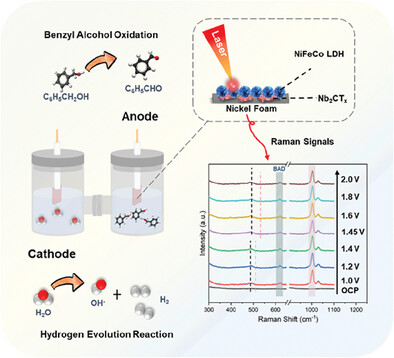
The study delves into the synergy between the 2D/2D heterostructured NiFeCo-LDH/Nb2CTx/NF (NFCM-400/NF) electrocatalyst, with in situ Raman-proven Ni(Co)OOH serving as the oxidation active sites. The research integrates this catalyst into a solar-powered electrolyzer, achieving up to 39.67% solar-to-hydrogen efficiency. The system efficiently converts benzyl alcohol to benzaldehyde while producing hydrogen, showcasing its potential for sustainable energy and chemical synthesis.
Frontispiece
Utilizing Two Electrokinetic Techniques on a Single Device for Detection of Extracellular Vesicle-Associated Protease Activity (Small 24/2025)
- First Published: 19 June 2025
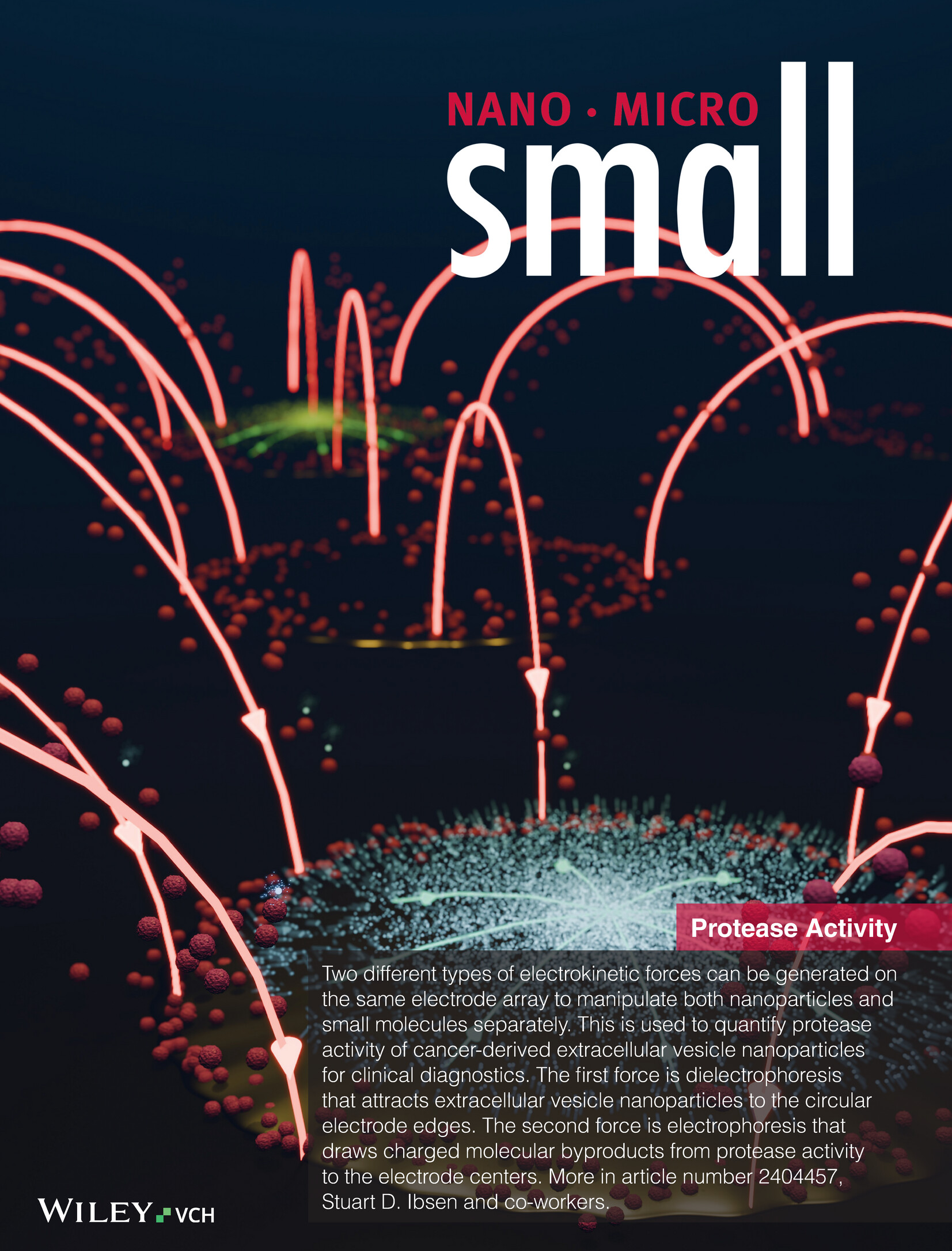
Protease Activity
Two different types of electrokinetic forces can be generated on the same electrode array to manipulate both nanoparticles and small molecules separately. This is used to quantify protease activity of cancer-derived extracellular vesicle nanoparticles for clinical diagnostics. The first force is dielectrophoresis that attracts extracellular vesicle nanoparticles to the circular electrode edges. The second force is electrophoresis that draws charged molecular byproducts from protease activity to the electrode centers. More in article number 2404457, Stuart D. Ibsen and co-workers.
Research Article
Utilizing Two Electrokinetic Techniques on a Single Device for Detection of Extracellular Vesicle-Associated Protease Activity
- First Published: 26 March 2025

Protease activity of cancer-derived extracellular vesicles is quantified using a single microelectrode array in a microfluidic device to create two different electrokinetic-based analyte collection mechanisms. First, dielectrophoresis is used to recover and purify EVs from plasma followed by electrophoresis to quantify protease activity using cleavable peptide substrates that produce fragments which are positively charged and fluorescent allowing them to be concentrated on the negative electrodes.
Frontispiece
Bio-Inspired Interlocking Micro-Patterning for Tunable, Switchable and Selective Adhesion in Wet and Dusty Environments (Small 24/2025)
- First Published: 19 June 2025
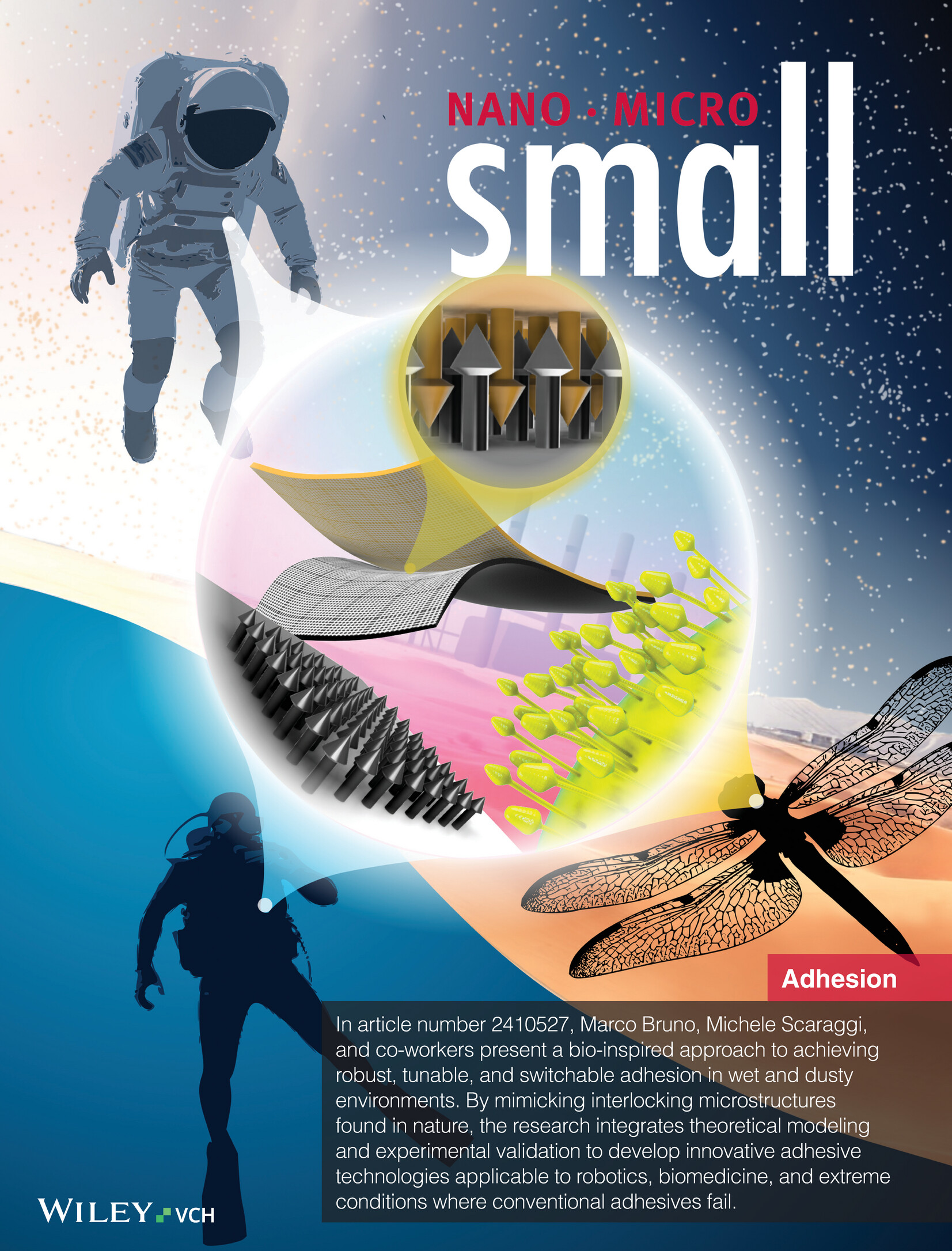
Adhesion
In article number 2410527, Marco Bruno, Michele Scaraggi, and co-workers present a bio-inspired approach to achieving robust, tunable, and switchable adhesion in wet and dusty environments. By mimicking interlocking microstructures found in nature, the research integrates theoretical modeling and experimental validation to develop innovative adhesive technologies applicable to robotics, biomedicine, and extreme conditions where conventional adhesives fail.
Research Article
Bio-Inspired Interlocking Micro-Patterning for Tunable, Switchable and Selective Adhesion in Wet and Dusty Environments
- First Published: 26 February 2025
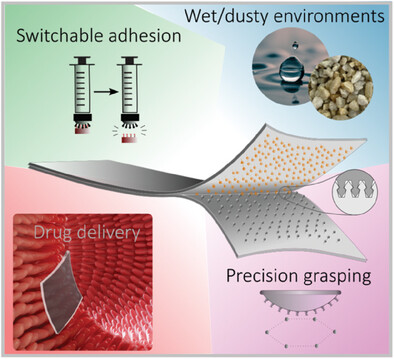
A new class of microfastener geometries is proposed, coming from biomimetic considerations and design optimization based on an original theoretical framework that is validated through testing and simulations. Demonstrators are assembled to present the impact that this technology can have on multiple fields: From precision grasping to drug delivery applications and underwater adhesives.
Modulating Solid-Solution Solubility to Enhance Thermoelectric Performance and Maintain Structural Stability in Phase-Transition Silver Chalcogenides
- First Published: 07 January 2025
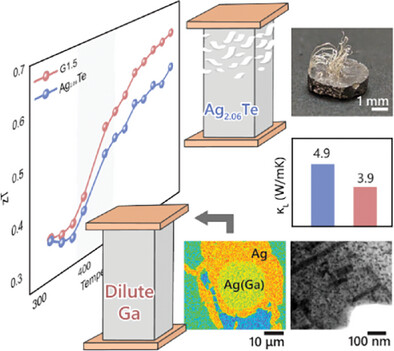
The mechanism behind silver whisker growth is revealed and propose a solution to inhibit it. By modulating the solubility of the silver solid solution through dilute Ga doping, the Ga-Ag2+xTe achieves enhanced thermoelectric performance, reaching a conversion efficiency of 2.3% with a ΔT of 300 K, and remains whisker-free after high-temperature testing, resulting in a thermally stable, high-performance thermoelectric device.
Infrared-Triggered Retinomorphic Artificial Synapse Electronic Device Containing Multi-Dimensional van der Waals Heterojunctions
- First Published: 03 March 2025
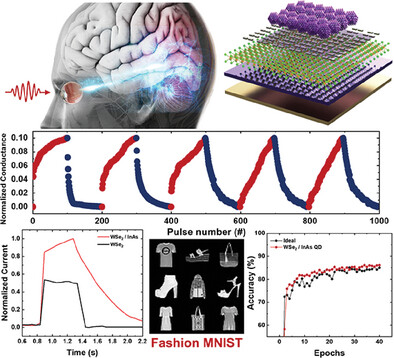
The study develops a retinomorphic artificial synapse using a WSe₂/InAs QD heterostructure, inspired by the human eye. It enhances SWIR responsivity (1060 nm) through quantum confinement, enabling efficient detection. This device surpasses Si-based and 2D/QD models, demonstrating superior synaptic properties and showcasing potential for machine vision and in-sensor computing through retina-inspired SWIR optoelectronic devices.
Ultraviolet-Resistant Flexible Perovskite Solar Cells with Enhanced Efficiency Through Attachable Nanophotonic Downshifting and Light Trapping
- First Published: 03 March 2025
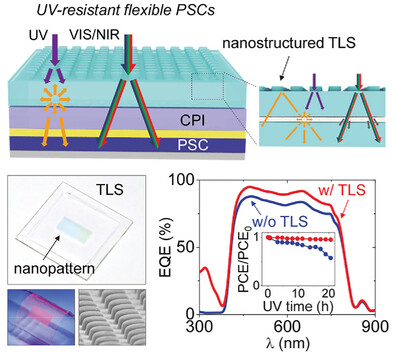
A broadly applicable strategy to achieve UV resistance, device flexibility, and uncompromised photovoltaic performance in perovskite solar cells is presented using a colorless polyimide with abrupt UV cut-off behavior and a nanostructured transparent luminescent sticker incorporating Eu-complex photon downshifter. Through the combined effects of downshifting and synergistic light trapping, the efficiency of UV-resistant PSCs is increased to 20.4%.
Molecularly Engineered Artificial Solid Electrolyte Interphase with Tailored Lithiophilicity and Solvent-Phobicity for Stable Lithium Metal Batteries
- First Published: 16 February 2025

This study presents a design strategy for developing artificial solid electrolyte interphase (SEI) for lithium (Li) metal to address Li dendrite growth and irregular SEI formation. The PEI-EH, consisting of lithiophilic nitrogen-rich polyethyleneimine and solvent-phobic hexyl moieties, effectively mitigates the issues of Li metal, achieving highly stable Li metal batteries.
Liposome-Polymer Nanoparticles Loaded with Copper Diethyldithiocarbamate and 6-Bromo-Indirubin-3′-Oxime Enable the Treatment of Refractive Melanoma
- First Published: 02 May 2025
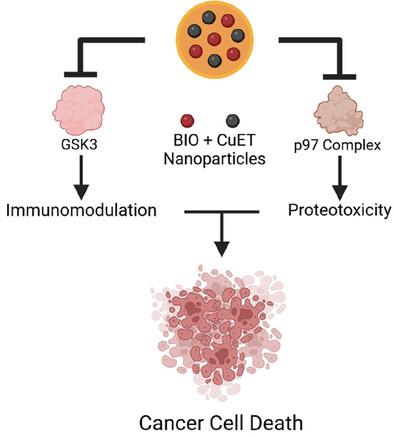
Cancer cells are exposed to heightened levels of endoplasmic reticulum stress and inflammation within the tumor microenvironment which can lead to therapeutic resistance. To address this issue, liposome-polymer nanoparticles loaded with copper diethyldithiocarbamate (CuET), a potent inhibitor of the p97-UFD1-NPL4 protein complex, and the anti-inflammatory drug 6-bromo-indirubin-3′-oxime (BIO), a potent GSK3 inhibitor, are used to treat advanced refractory melanoma. Created with BioRender.com.
Inverse Opal Torus-Shaped Photonic Microobjects with Superior Stimulus-Responsive Properties to Their Spherical Equivalents
- First Published: 16 April 2025
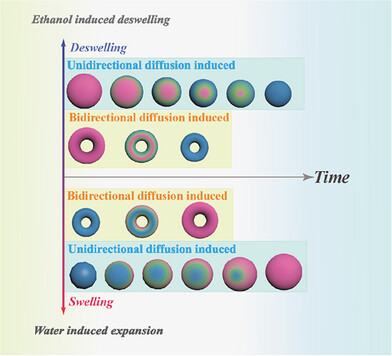
This work visually shows that material exchange can be significantly improved by using inverse opal torus-shaped (TS) photonic microobjects made of stimulus-responsive hydrogel. The microobjects work better than their spherical equivalents, which rely on unidirectional diffusion, because of their unique architecture that permits bidirectional diffusion, especially when quick and uniform expansion or shrinkage is involved.
Van der Waals Epitaxy of 2D Gallium Telluride on Graphene: Growth Dynamics and Principal Component Analysis
- First Published: 02 May 2025
Surface-Sensitive Fractioning of Flowing Colloidal Suspensions Sedimented at a Photochemically Active Wall
- First Published: 12 May 2025
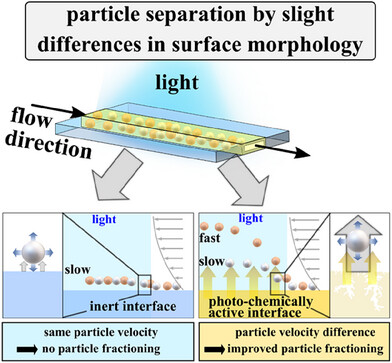
A straightforward technique for fractionating sedimented, same-sized colloidal particles based on small differences in their surface properties is described. This microfluidic technology method exploits the velocity differentials within a shear-flow via inducing a phoretic lift above the bottom porous polymer interface that is capable of light-induced release of a stored photosensitive surfactant.
Vacuum-Evaporated Perovskite and Interfacial Modifier for Efficient Perovskite Solar Cells
- First Published: 02 May 2025
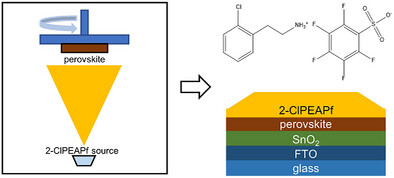
A scalable vacuum evaporation method uniformly deposits multifunctional 2-ClPEAPf on perovskite surfaces, enabling defect passivation and moisture resistance without forming low-dimensional phases. The solvent-free approach produces a homogeneous 2-ClEPAPf layer, achieves high-efficiency planar perovskite solar cells with operational stability and compatibility for large-area fabrication, offering a practical pathway toward robust and industrially viable photovoltaic devices.
Covalent Crosslinker-Free Photo-Curing 3D Printing of Liquid Metal Composite Hydrogels Based On SI-photoATRP
- First Published: 03 May 2025
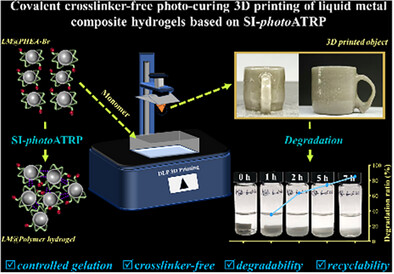
This work demonstrates the surface-initiated photoinduced atom radical transfer polymerization (SI-photoATRP) on the surface of liquid metal droplets, which induced the formation of degradable hydrogel without a covalent crosslinker. Importantly, by integrating the ultra-fast photoinduced aqueous phase ATRP system catalyzed by carbon dots, complex structures of the LM@polymer composite hydrogel are successfully established through DLP technology.
Imine-Linked Covalent Organic Frameworks Tuned by Quaternary-Ammonium-Alkyl for Highly Effective and Selective Adsorption of Perchlorate from Water
- First Published: 21 April 2025
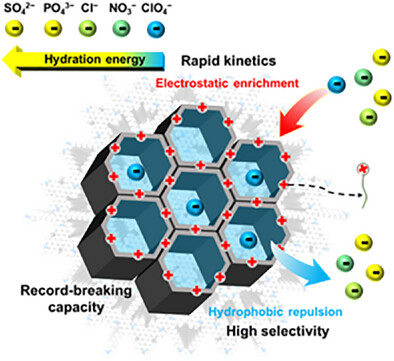
A cationic hydrophobic COF with an adsorption capacity (912 mg g⁻¹) surpassing reported materials is developed for selective and efficient perchlorate adsorption. Utilizing electrostatic enrichment, hydrophobic interactions, and hydrogen bonding, it achieves highly selective perchlorate adsorption from water. Additionally, it exhibits excellent stability and recyclability, underscoring its potential for advanced water purification.
Enhanced Backgate Tunability on Interfacial Carrier Concentration in Ionic Liquid-Gated MoS2 Devices
- First Published: 22 April 2025
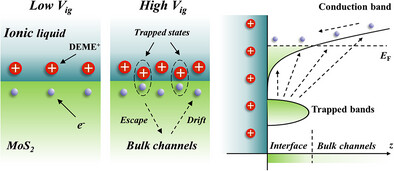
High ionic gate voltages induce carrier localization in interfacial trapped bands via crowded ion distributions. The bulk channels facilitate carriers escaping from trapped bands into the ionic liquid-TMDs interface and then participating in electric transport. Backgate-controlled doping or depletion of the bulk channel provides a mechanism to modulate the strength of this back tunneling process.
Reactive Polymers of Intrinsic Microporous Aerogels for Rapid Mustard Gas Detoxification
- First Published: 02 May 2025
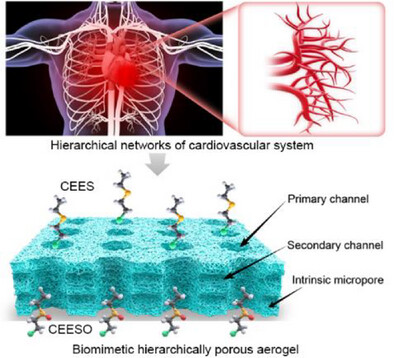
Inspired by the fractal structure in nature, polymers of intrinsic microporous nanofibers are used as building units to prepare reactive aerogels with a hierarchical porous structure through a combined freeze-drying and chlorination approach. The resulting aerogels exhibit integrated performances including low mass-transfer resistance, rapid vesicant simulant detoxification capability (half-life of 1.27 min), and high structural stability.
In Situ Monitoring of Redox Electrochemistry of Perylene Diimide Electrodes by UV–Vis–NIR Spectroscopy
- First Published: 21 April 2025
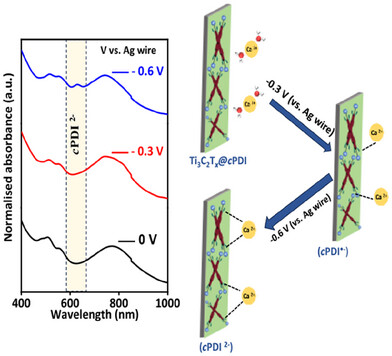
This work discusses the fabrication of Ti3C2Tx@cPDI thin film electrodes to investigate the electrochemical storage of calcium ions. Ti3C2Tx@cPDI thin film electrode stores the calcium ion via electrochemical reduction of cPDI to its radical anion and dianion at specific potentials, giving rise to pseudocapacitive behavior. Stable and reversible electrochemical reduction of cPDI is monitored through in situ UV–Vis–NIR spectroscopy technique.
Supramolecular Nanoplatforms with Activable Ultrasound and Magnetic Resonance Imaging for Cancer Diagnosis and Therapy
- First Published: 24 April 2025
Engineering Triple Phase Interface and Axial Coordination Design of Single-Atom Electrocatalysts for Rechargeable Zn─air Batteries
- First Published: 09 May 2025
Strong and Anti-Impact Multi-Functional Elastomer via Hierarchical Hydrogen Bonding Design
- First Published: 30 April 2025
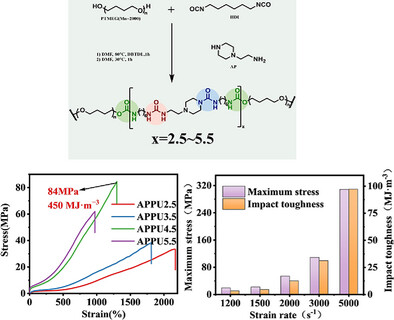
A multifunctional elastomer with high strength, toughness, and impact resistance is developed by designing multiscale structures. The synergistic effects of hydrogen bonds, rigid-flexible chain coordination, and optimized hard/soft block ratio lead to superior mechanical performance. The material also exhibits thermal adhesion and fluorescence capabilities, expanding its functional applications. This strategy offers new insights into elastomer structure-property relationships.
Preparation of Highly Efficient All-pH Bifunctional Water Electrolysis Catalysts Through a Surface Modification Strategy
- First Published: 24 April 2025
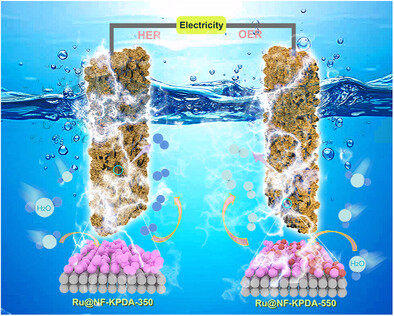
By surface modification of nickel foam through the redox reaction of trace ruthenium (Ru) with Ni and dopamine hydrochloride protection strategy, Ru@NF-KPDA-350 and Ru@NF-KPDA-550, have been successfully developed, which exhibit remarkable performance for both oxygen evolution reaction (OER) and hydrogen evolution reaction (HER) across a broad pH spectrum. However, these catalysts have their own advantages.
Vanadium-Stabilized MoB Nanoparticles Enable Hydrogen Evolution at Industry-Relevant High Current Densities
- First Published: 23 April 2025
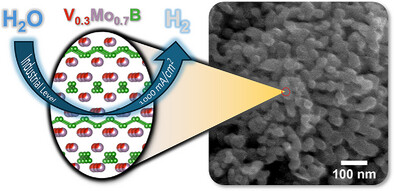
In this study, the synthesis of vanadium-stabilized molybdenum monoboride (V0.3Mo0.7B) nanoparticles is reported that outperform Pt/C at industry-relevant current densities under the same experimental conditions, achieving 1000 mA cm−2 with an overpotential of just 0.452 V compared to 0.837 V for Pt/C.
Unraveling Lithium-Ion Migration Mechanisms in Novel Quasi-Layered Argyrodite Solid Electrolyte for All-Solid-State Battery
- First Published: 22 April 2025

This work investigates the ionic conductivity and Li-ion migration mechanisms of Argyrodite solid-state electrolytes in the P2mm space group. It highlights the influence of anion frameworks on Li-ion transport, revealing Cl− ions promote faster migration while I− ions can hinder it. Innovative methods for calculating ion migration activation energy are also proposed, enhancing electrolyte design.
Heterocyclic Conjugated Polydentate Ligands Facilitate Interfacial Charge Transfer of Air-Processed Carbon-Based All Inorganic Perovskite Solar Cells with an Efficiency Over 15%
- First Published: 21 April 2025
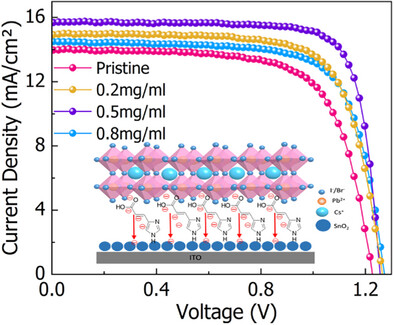
Modulating charge transfer at buried interfaces in all-inorganic carbon-based perovskite solar cells (C-PSCs) is crucial to achieve high performance devices. A conjugated polydentate buried interfacial modifier, 4-imidazolylacrylic acid (UA), enhances conductivity of tin oxide, passivates interfacial defects, and facilitates energy level alignment, resulting in improved efficiency (PCE increased from 11.91% to 15.56%) and better long-term stability compared to control devices.
Operando Measurement of Transition Metal Deposition in a NMC Li-Ion Battery Using Laboratory Confocal Micro-X-ray Fluorescence Spectroscopy
- First Published: 18 April 2025
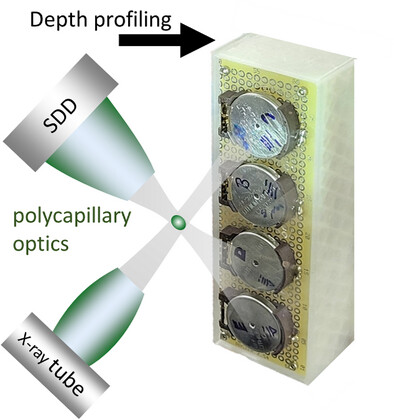
Transition metal dissolution in Li-ion batteries can lead to reduced battery performance. To monitor elemental migration during cyclization, laboratory confocal micro-X-ray fluorescence spectroscopy is used. The investigation of a nickel-manganese-cobalt-oxide (NMC) coin cell during thousands of charging cycles shows increasing Mn deposition in the graphite anode during the first 6 weeks of cyclization.
Multilevel Intelligent Anti-Counterfeiting Label with Spatially Selective Dynamic Aurora Response and 3D Mesoscopic Physical Unclonable Function Fingerprint
- First Published: 02 May 2025
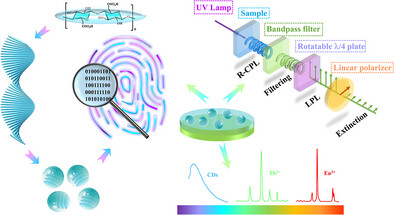
A novel double-layer composite film is proposed, breaking the tradition that cellulose nanocrystals can only provide circular polarized light properties to nanoscale fluorescent materials. The composite film integrates three levels of optical anti-counterfeiting information: full-chromatographic tunable photoluminescence, spatially selective random dynamic aurora responses, and 3D bionic mesoscopic physical unclonable functions fingerprints.
Microenvironment-Engineered Multilayered Electrode Design for Sustainable Seawater Oxidation
- First Published: 27 April 2025
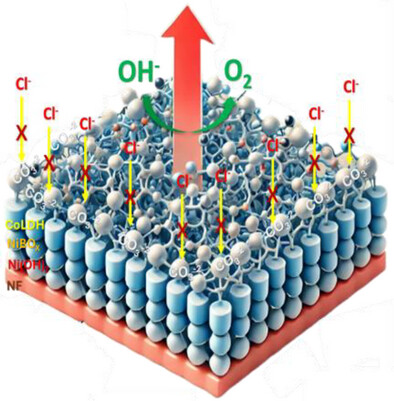
A microenvironment-engineered multilayered electrode integrates CO₃2⁻ Lewis base sites on Co LDH within a boron-doped NiBOx framework to enable efficient and stable seawater electrolysis. The design enhances OER kinetics, prevents chloride-induced corrosion, and supports sustainable, desalination-free hydrogen production.
Ligand-Engineering MoS2-Osmium Heterostructure as Highly Active and Specific Peroxidase-Mimic Nanozyme for Interference-Free and Multimode Biosensing
- First Published: 02 May 2025
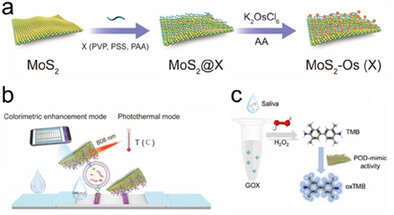
This study designs ligand-engineered Molybdenum disulfide (MoS2)-osmium (Os) heterostructures via polyvinylpyrrolidone (PVP)-mediated confinement of amorphous Os nanoclusters, synergistically boosting peroxidase activity/specificity and photothermal efficiency. The dual-mode biosensor achieves ultrasensitive detection of HER2⁺ exosomes and salivary glucose (0.1 µM limit), offering 100-fold higher sensitivity than commercial kits, advancing multifunctional nanozyme design for biosensing.
Exosome-Functionalized Self-Carrier Enzyme-Like/Drug With Triple Amplified Anti-Oxidative Stress for Synergistic Depression Therapy
- First Published: 22 April 2025
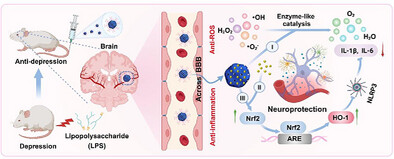
The short summary: GEN-loaded porous Prussian Blue (PB) nanoparticles encapsulated in macrophage exosomes (PBGE) offer triple amplified anti-oxidative stress for treating LPS-induced inflammatory depression. PB scavenges ROS, protects GEN from oxidative degradation, and synergistically activates the Nrf2-ARE pathway, enhancing antioxidant defense and demonstrating the potential for novel antidepressant therapies.
d-Orbital Single Electron Filling O─O π* Bonds on WO3S1 Sites for Highly Selective Generation of Hydroxyl Radicals
- First Published: 24 April 2025
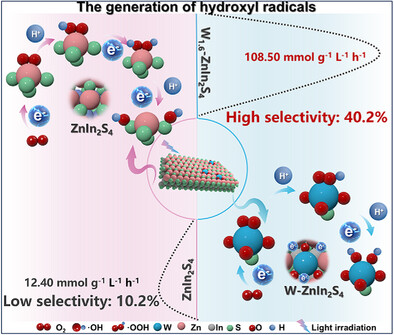
Tungsten single-site co-coordinated with O and S atoms (WO3S1) is established on ZnIn2S4, which can efficiently and selectively generate hydroxyl radicals. The d-orbital single electron (↑, _, _, _, _, _) for W sites effectively fill the π* bonds of O─O in O2 and the •OOH intermediate, activating O2 and shortening the pathway for •OH generation (O2→•O2-→•OOH→•OH), leading to selective production of •OH.
In Situ Preparation of Ultra-Thin and High-Entropy FeCoNiMnMo Nanosheet Arrays to Achieve Efficient Water/Seawater Oxidation at Large Current Density
- First Published: 26 April 2025
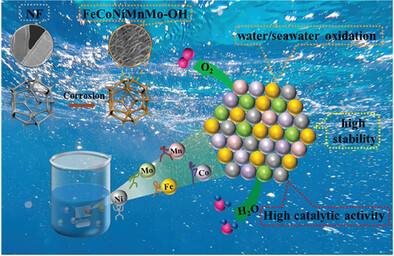
A simple “corrosion engineering” strategy is proposed to prepare ultra-thin and high-entropy nanosheet arrays, with ultra-low overpotential and high stability for water/seawater oxidation at high current density, whose excellent activity is due to the high entropy effect, the synergistic effect between multiple elements, and the unique ultra-thin nanosheet arrays.
Boosted Nanocrystalline Magnetic Softness via Atomic Immiscibility Induced Chemical Heterogeneity
- First Published: 26 April 2025
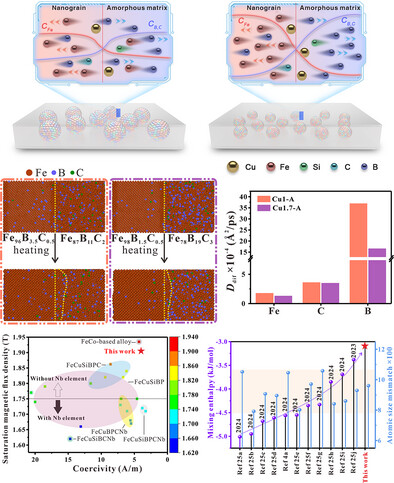
This study designs an enhanced atomic immiscibility system (Fe86Si1.3B9C2Cu1.7) via deep supercooling solidification, which induces chemical heterogeneity to promote nucleation and inhibit grain growth. The resulting dense and fine nanograins lead to smooth magnetic domain motion and improve soft magnetic properties, exhibiting Bs of 1.90 T and Hc of 4.0 A m−1.
A Coral Shell-Inspired Biomimetic Soy Protein Adhesive Toward Electromagnetic Shielding Wood-Based Composites
- First Published: 25 April 2025
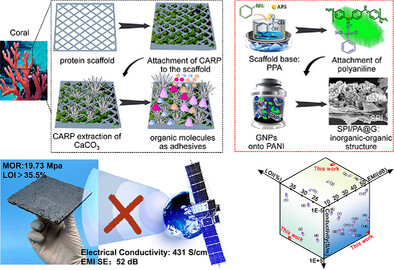
This study develops a multifunctional soy protein adhesive through inorganic-organic hybridization using hierarchical polyaniline/phenylphosphonic acid-loaded graphene nanoplatelets. The resultant wood-based composite materials have high bending strength (19.7 MPa), flame retardancy (limiting oxygen index 35.5%), electrical conductivity (43100 S m−1), and electromagnetic shielding effectiveness (52.1 dB), showing promising application prospects in aerospace, sensitive precision electronics, and other fields.
Amorphous RuO2 Nanozymes with an Excellent Catalytic Efficiency Superior to Natural Peroxidases
- First Published: 25 April 2025
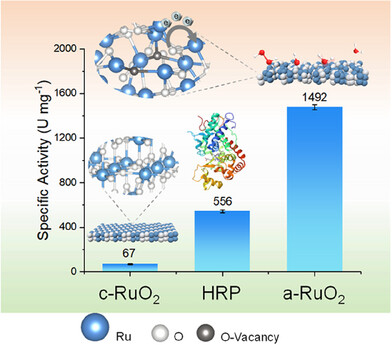
Due to the abundant oxygen vacancies and long-range disordered structures, amorphous RuO2 nanozymes demonstrate significantly enhanced peroxidase-like activity, which is 2.8 times superior to natural peroxidases. Accordingly, the RuO2 nanozymes as the ideal alternative to natural enzymes can achieve an efficient immunoassay of prostate-specific antigen with practical feasibility in clinical diagnosis.
Unraveling the Synergy of Interfacial Engineering in In Situ Prepared NiO/NdNiO3 for ppb-Level SO2 Sensing: Mechanistic and First-Principles Insights
- First Published: 23 April 2025
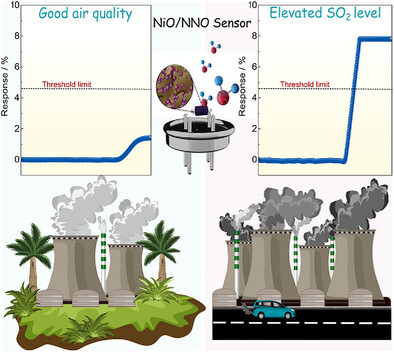
This study demonstrates highly sensitive SO2 detection with an in situ prepared NiO/NdNiO3 as the sensing layer. The synergy of interfacial engineering enables a sensor featuring an extended detection range (0.45–200 ppm) and superior performance. Theoretical calculations reveal NiO drives SO2 adsorption, while NdNiO3 enhances signal transduction. The fabricated portable prototype highlights its potential for industrial and environmental monitoring applications.
Optimizing Adsorption-Catalysis Synergy to Accelerate Sulfur Conversion Kinetics in Room-Temperature Na-S Batteries
- First Published: 25 April 2025
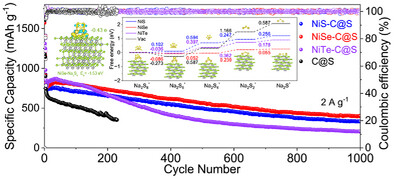
A series of nano-sized nickel-based chalcogenides were successfully designed and prepared as catalysts for the sulfur cathode of room-temperature sodium-sulfur (RT Na-S) batteries by a simple spray-drying method. Guided by the Sabatier principle, theoretical and experimental comparisons revealed that NiSe exhibits a balance of adsorption and catalytic abilities among the tested catalysts, thereby enhancing soluble sodium polysulfides (NaPSs) conversion kinetics.
Renewable Photosensitive Castor Oil to Fabricate Ionogels: Freezing-Tolerance, Stretchability, and Degradation for 3D Printing and Flexible Sensor Applications
- First Published: 30 April 2025
Dynamic Induction of Conversion−Based Anode Degradation by Valence State and Mechanical Cracks
- First Published: 26 April 2025
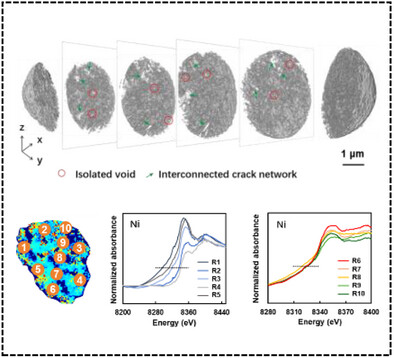
The study employs spatially resolved synchrotron-based X-ray microscopy combined with XANES spectroscopy to uncover dynamic physicochemical failure mechanisms in NiS2 particles during potassiation/depotassiation, revealing crack propagation and chemical valence heterogeneity as key degradation factors. A tailored dimension engineering strategy is proposed to enhance structural stability, advancing high-capacity and highly stable potassium-ion battery design.
A Lifetime Nanosensor for In Vivo pH Quantitative Imaging and Monitoring
- First Published: 23 April 2025
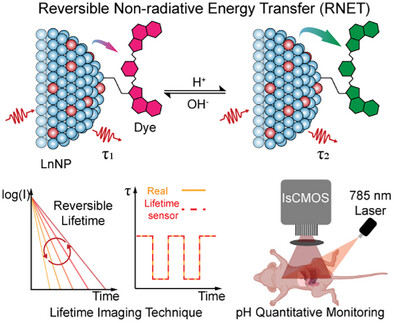
A long-lifetime nanosensor based on a lanthanide-dye nanocomposite for non-invasive, quantitative in vivo pH monitoring is presented. The sensor's performance is based on significant reversible changes in the dye's molar extinction coefficient and energy transfer efficiency, making it resistant to biological tissue interference. It successfully tracks pH variations in the mouse gastrointestinal tract, demonstrating robust pH monitoring capabilities for theranostic applications.
Unveiling the Effect of Polymerization Values on the Crystallization Behavior of Perovskite Films for Efficient and Stable Solar Cells
- First Published: 26 April 2025
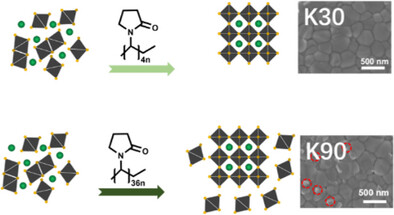
PVP with varying DP values (K15, K30, and K90) are systematically screened and adopted as the additive to control the crystallization process of perovskite. Among them, the K30 exhibited a suitable viscosity and binding strength, which effectively controlled the crystal growth process via retarding the intermediate phase, resulting in excellent device efficiency and improved stability.
Flexible Single-Atom Cesium Sites on Amorphous MgO Nano-Cushions for Enhanced CO2-Involved Multi-Step Reactions
- First Published: 24 April 2025
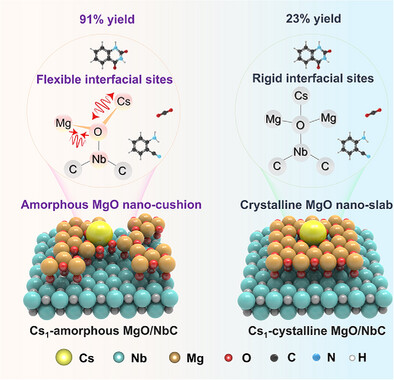
The atomic-amorphous-crystalline (A-A-C) Cs1-a-MgO-NbC hybrid catalyst forms a miscible hetero-phase boundary via an amorphous MgO nano-cushion interlayer. This interlayer permits flexible deformation of interfacial metal-oxygen sites, enabling diverse catalytic pathways for converting CO2 into high-value chemicals under ambient pressure, surpassing conventional crystalline counterparts.
Achieving Ultra-Thin Solid Electrolyte Interphase for High-Performance Lithium Metal Anodes via Chloride-Assisted Electrochemical Corrosion
- First Published: 26 April 2025
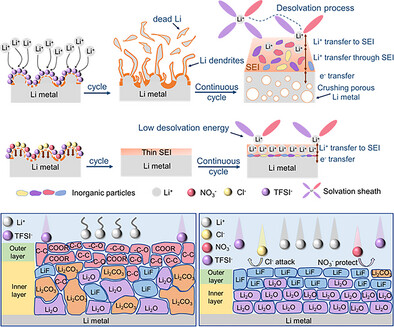
In this paper, Cl− and NO3− are introduced into electrolytes to reduce the solvent desolvation energy and the accumulation of Li on the Li metal surface. In addition, Cl− can preferentially attack the organics and Li2CO3, whereas NO3⁻ can mitigate the corrosion of Cl−, generating a promising solid electrolyte interphase (SEI) layer for Li metal anode with 100 nm thickness and enriched with LiF and Li2O.
Hydrophilic/Hydrophobic Composite Catalysts to Enhance Contact-Electro-Catalytic Performance of Polytetrafluoroethylene
- First Published: 05 May 2025
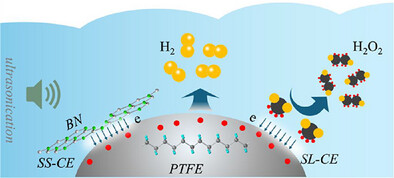
An effective strategy is proposed to enhance contact-electro-catalytic (CEC) efficiency by developing hydrophobic/hydrophilic composites. Notably, the boron nitride /polytetrafluoroethylene (BN/PTFE) composite demonstrates exceptional CEC performance, achieving a hydrogen yield of 15.73 mmol g⁻¹ h⁻¹ and a nitrogen reduction rate of 17.25 mmol g⁻¹ h⁻¹. Both experimental and theoretical results reveal significant electron transfer between PTFE and water, as well as between PTFE and BN.
Stabilize Perovskite Precursors and Inhibit Intermediates for High Performing Perovskite Solar Cells
- First Published: 24 April 2025
Enhanced Spin Relaxation Time in a 2D/1D Van Der Waals Hybrid Heterostructure
- First Published: 27 April 2025

The chemical functionalization of graphene with fullerene (C60) improves the spin relaxation time in the graphene. This is demonstrated by a novel nanofabrication methodology, which is beyond the present state-of-the-art, and in which organic molecules are interfaced with graphene spintronic nanodevices through custom-made hexagonal boron nitride (hBN) stencil masks without the use of complex orthogonal solvents.
Flexible and Scalable Magnesium Replenishment in NCM Cathode Enabled by Mobile Mg2+ Enriched MgV2O4
- First Published: 27 April 2025
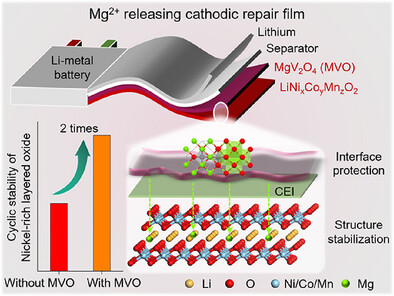
The novel strategy has been provided for achieving high-performance Li-metal batteries and can be extended to other micro-releasing systems, providing insights for improving the stability of NCM in practical energy storage applications. It offers scalable design strategies for the development of advanced cathode materials for commercially viable batteries.
Nanoconfined Solvothermal Synthesis of Defective 1T-MoS2 Monolayers with High Electrocatalytic Performance
- First Published: 24 April 2025

A scalable nanoconfined solvothermal method is reported to synthesize metallic phase MoS2 monolayers (97% monolayer ratio, 89% 1T phase) with controlled defect density, uniform size, and high dispersibility in solvents. These nanosheets exhibited exceptional HER performance, achieving 315 mV overpotential at 1000 mA cm−2 and stable operation, outperforming commercial Pt/C. This approach advanced scalable 2D material synthesis for practical applications.
Sharply Improved Electrical Insulation of Polyimide Dielectrics at Elevated Temperatures by Charge Reassignment Engineering
- First Published: 22 April 2025
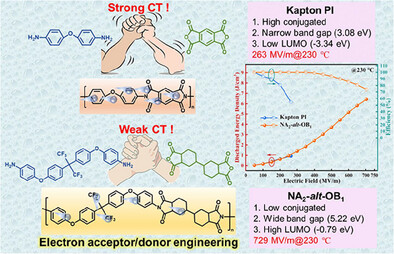
Charge rearrangement engineering not only reduces the conjugation degree of the main chain of polyimide but also improves the bandgap and LUMO level to reduce the excitation/injection electrons from inside/outside the material, and finally realizes the apparent improvement of high-temperature energy storage performance for polyimide dielectrics.
Cellulose Nanocrystal Stabilized Liquid Metal Pickering Emulsion as Photothermal and Conductive Direct-Writing Ink
- First Published: 22 April 2025
Effect of Internal Electrostatic Fields on Self-Powered X-Ray Detectors with High Sensitivity and Low Detection Limits in Polar Oxide Crystals α/β-BaTeMo2O9
- First Published: 18 April 2025
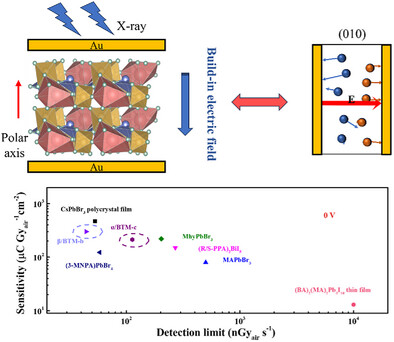
The macroscopic polarization in polar materials can generate the internal electrostatic field, so the oxide crystal is used with the polar structure to realize the self-powered X-ray detector with high sensitivity, low detection limit, and stable performance. The comparison of oxide crystal X-ray detectors based on different configurations provides a new way to explore green and high-performance self-powered X-ray detectors in the future.
Crystal Field Stabilization Energy Asymmetrically Constructed Built-in Electric Fields for Efficient Water Cracking
- First Published: 24 April 2025

Inspired by crystal field stabilization energy difference in NiS and Ni2P, a built-in electric field is constructed within a self-supported heterogeneous NiS/Ni2P@Ni foam. The asymmetrical coordinate atoms induce the electron rearrangement to regulate the adsorption properties of O/H-containing intermediates, hereby the hetero-phase serves as the active species for OER and HER, respectively.
Restructuring of Hydrogel Polymer Networks via Ion Storming
- First Published: 07 May 2025
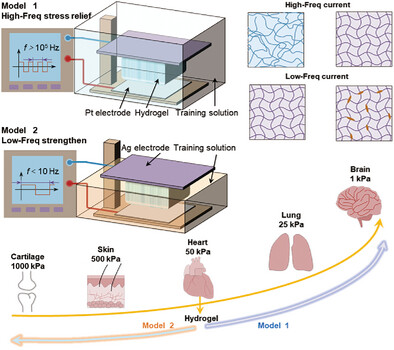
Hydrogels have weak mechanical properties due to the disordered polymer networks. Traditional methods improve strength but need complex processing. This study demonstrates that the ions in hydrogels align polymer networks under the electric field, restructuring its softness and toughess via the high-frequency vibration and low-frequency coordination, respectively, which enhances the 3D-printed hydrogel performance.
Controllable Ultrathin Thickness of Carbon Nanotubes Layers and Ultralow Equivalent Content in Alternating PMMA-Based Nanocomposites for Optimized Impedance Matching to Achieve Wideband Electromagnetic Absorption
- First Published: 05 May 2025

A novel multilayer nanocomposite with ultrathin CNTs layers and ultralow filler content (1 wt.%) is developed using an exponential stacking strategy. The alternating PMMA/CNTs structure enables optimized impedance matching and strong attenuation, achieving high-performance electromagnetic wave absorption with minimal thickness, weight, and material usage—offering a promising solution for lightweight EM shielding applications.
Copper-Coordination Engineered Glassy Hydrogels Featuring Ultrastiffness and Structural Programmability
- First Published: 24 April 2025

This research develops an ultrastiff, ultrastrong glassy hydrogel by introducing tough coordination bonds into the polyacrylic acid and polyvinyl alcohol network, using a copper acetate-assisted strategy. The resultant glassy hydrogel exhibits record-breaking Young's modulus (469.7 MPa), tensile strength (19.2 MPa), environmental stability, and reversible softening-vitrification changes. These features allow for the elaboration of the integrated auxetic hydrogel.
Enhancing Interfacial Contact in Perovskite/Silicon Tandem Solar Cells Through TaOX Passivation
- First Published: 05 May 2025
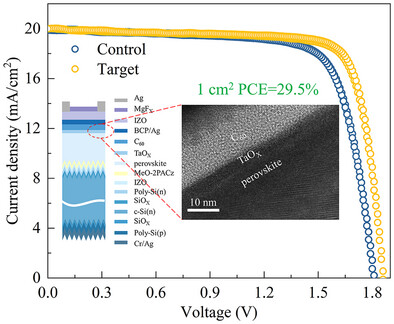
For the first time, TaOX is introduced into inverted perovskite solar cells, effectively suppressing non-radiative recombination at the perovskite/C60 interface and optimizing the energy level alignment. This interface engineering strategy led to a perovskite/silicon tandem solar cell with a remarkable power conversion efficiency of 29.5%, accompanied by enhanced device stability.
(ReMoV)X2 (X = S, Se) Ternary Alloy Nanosheets for Enhanced Electrocatalytic Hydrogen Evolution Reaction
- First Published: 24 April 2025
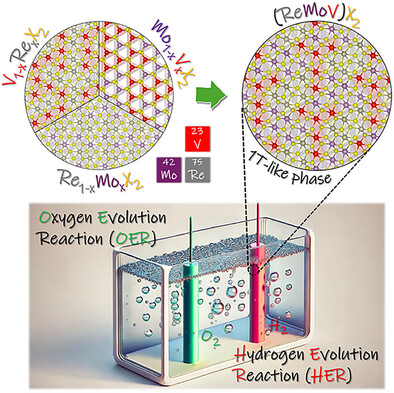
Composition-tuned (ReMoV)X2 (X = S, Se) ternary alloy nanosheets are synthesized using solution reactions. A homogeneous atomic mixing occurred in the metallic 1T phase. The electrocatalytic activity toward the acidic hydrogen evolution reaction is enhanced for the sulfide nanosheets. Density functional theory calculations supported the experimental data.
Measurement of Anisotropic Exciton Transport Lengths in Organic Crystals Using Photoetching
- First Published: 28 April 2025
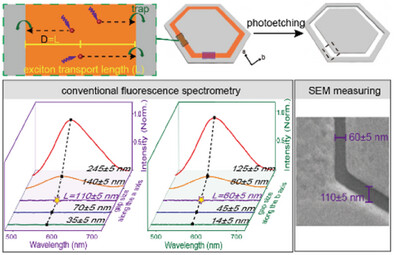
A photoetching method is developed for precisely determining the anisotropic exciton transport lengths within 2D structures at the nanoscale. This method can visualize the active middle segments as gaps for accurate size measurement by scanning electron microscope (SEM). The method enables the application of conventional fluorescence spectrometry to determine the anisotropic exciton transport lengths within the middle segment.
Surface Reconstruction of Amorphous Ni─Co─S─O Material with a Functional Gradient Layer for Highly Efficient and Stable Alkaline Hydrogen Evolution
- First Published: 22 April 2025

The prepared amorphous 3Ni─Co─S─O material undergoes a surface composition reconstruction process across a thickness of ≈6 µm during HER, forming a functional gradient layer. Within this layer and its amorphous nature, the 3Ni─Co─S─O catalyst exhibits superior alkaline HER activity requiring only 170 mV to reach an industrial HER current density of 1000 mA cm−2 and remarkable stability.
Acid-Responsive Disassembly of Nanomedicines for Extracellular Drug Delivery Reversing Glioblastoma Immunosuppressive Microenvironment by Targeting the Adenosine-A2AR Pathway
- First Published: 27 April 2025
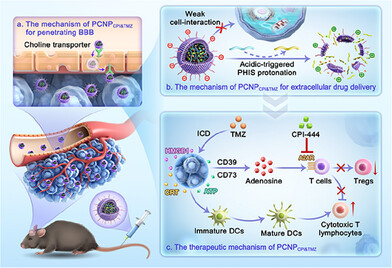
This study developed an acidity-responsive phosphatidylcholine (PC) -coated nanoparticle (PCNP) with low cell internalization. PCNP effectively penetrates the blood–brain barrier and minimizes tumor cell internalization through the PC component. Following protonation of the poly-l-histidine core, PCNP undergoes disintegration and rapid releases of the encapsulated CPI-444 and temozolomide in the extracellular space, enhancing immune effects through targeting the adenosine-A2AR pathway.
2D Semiconductors Directly Grown on Si with Room Temperature Mobility Exceeding 2000 cm2 V−1 s−1
- First Published: 27 April 2025

The direct growth of Bi₂O₂Se nanoflakes on Si substrates is reported using an oxygen-assisted chemical vapor deposition (CVD) technique, achieving a record room temperature carrier mobility exceeding 2000 cm2 V⁻¹ s⁻¹. This value surpasses all previously reported mobilities for Bi₂O₂Se and represents a significant advancement in high-performance 2D semiconductors.
Highly Crystalline and Robust Donor-Acceptor Type Covalent Organic Frameworks for Long-life Sodium-Ion Battery Cathodes
- First Published: 25 April 2025
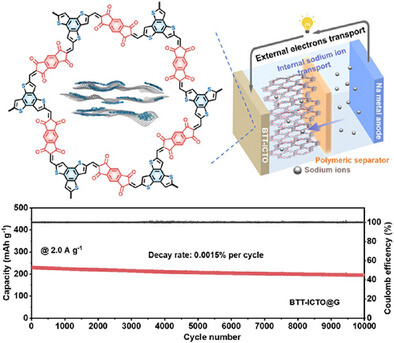
Highly crystalline and robust donor-acceptor type covalent organic frameworks (COFs) with abundant, highly accessible active sites for long-life sodium-ion battery cathodes are developed. Benefitting from the well-designed COF@graphene composites, the corresponding sodium-ion battery shows high capacity, excellent rate capability, and exceptional cycling performance.
Monolithic Perovskite/Silicon Tandem Solar Cells Enabled by Multifunctional TiOx Interconnects
- First Published: 27 April 2025
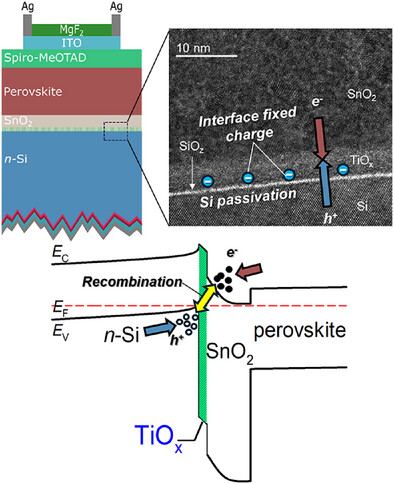
TiOx nanolayer enables a series interconnection of a perovskite top cell with a silicon wafer directly in perovskite/silicon tandem solar cells. The TiOx serves as an all-in-one interconnect, providing surface passivation, hole transport, and recombination junction. A TiNy capping layer boosts performance to a level comparable to that of conventional tandem devices employing amorphous silicon and indium oxide layers.
Synergistic Cu@Ni–N–C Yolk@Shell Nanostructure Catalyst for Selective Acetonitrile Electroreduction to Ethylamine
- First Published: 27 April 2025
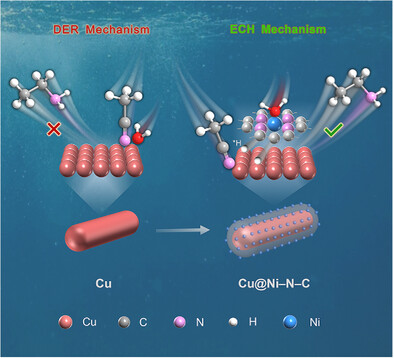
An efficient yolk@shell-structured Cu@Ni–N–C catalyst for selective CH3CN electroreduction to CH3CH2NH2 is prepared by a confinement strategy. The introduction of Ni–N–C layer tailors the hydrogenation pathway from a direct electroreduction (DER) mechanism into a more favorable electrochemical hydrogenation (ECH) mechanism, thus leading to the significantly enhanced electrocatalytic performance of Cu@Ni–N–C yolk@shell nanostructure.
Engineering the Undercoordinated Edge-Rich Single-Crystal Microreactors for High-Performance Lithium─Sulfur Batteries
- First Published: 02 May 2025

A simple hydrothermal and calcination strategy is employed to prepare a microreactor composed of undercoordinated edge-rich single-crystal nickel─cobalt bimetallic oxide embedded with a carbon nanotube (CNT) conductive network (NCO@CNT). The relevant electrochemical performance and theoretical calculations confirms that the oxygen-deficient coordination in the microreactor induces electron redistribution of the metal atoms, thereby enhancing their electron exchange with polysulfides.
Fe-Doped Ni-Phytate/Carbon Nanotube Hybrids Integrating Activated Lattice Oxygen Participation and Enhanced Photothermal Effect for Highly Efficient Oxygen Evolution Reaction Electrocatalyst
- First Published: 26 April 2025
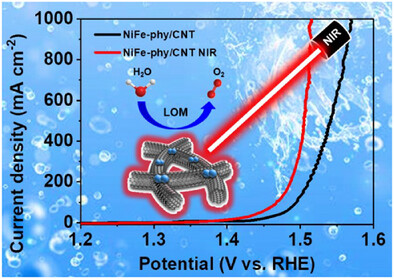
NiFe-phy/CNT, which simultaneously follows the lattice oxygen mechanism and exhibits a photothermal effect, is developed through a facile and scalable co-precipitation method. The incorporation of Fe can switch OER pathway from AEM to LOM and reinforce the photothermal effect of the electrocatalyst, thereby significantly boosting its OER activity. The optimized NiFe-phy/CNT only requires low overpotentials of 336 and 286 mV at 1000 mA cm−2 without and with NIR irradiation, respectively.
Effects of DNA Origami-Based Nanoagent Design on Apoptosis Induction in a Large 3D Cancer Spheroid Model
- First Published: 25 April 2025
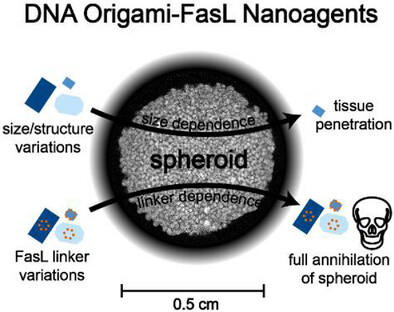
The ability of DNA origami to penetrate through spheroid tissue and to induce cell death via the extrinsic apoptosis pathway is examined. Both structure of the DNA origami and the attachment of the apoptosis-inducing ligands are varied. The penetration is dependent on DNA origami size, not flexibility, but the apoptosis efficacy is dependent on ligand attachment flexibility.
Breaking the Trade-Off Between Complexity and Absorbing Performance in Metamaterials Through Intelligent Design
- First Published: 27 April 2025
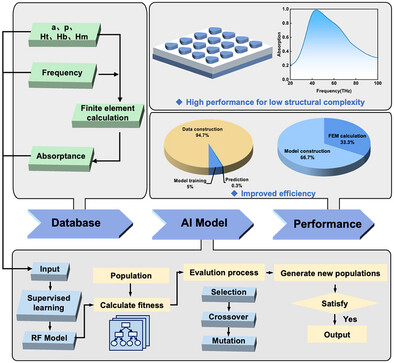
Here, a Sahara silver ant-inspired, simplified metamaterial structure is utilized to achieve broadband selective absorption, enabled by a highly efficient and adaptable artificial intelligence (AI) algorithm. These AI-designed metamaterials demonstrate superior broadband absorption, with an average absorptance above 0.9 in the 5–8 µm band, outperforming or matching those with more complex designs. This innovation moves beyond traditional approaches that compromise processing efficiency for structural complexity.
P-N Series Integrated Ionic Thermoelectric Generator Based on Cation/Anion-Selective Hydrogels for Body Heat Harvesting
- First Published: 27 April 2025
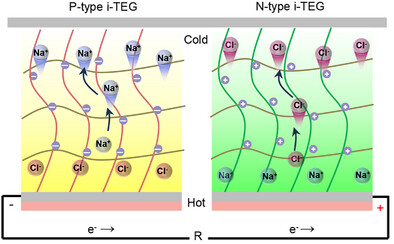
This study enhances ionic thermoelectric generator efficiency by using ion-selective hydrogels with sodium chloride. The anionic polymer in cation-selective hydrogel attracts sodium ions, while the cationic polymer in anion-selective hydrogel attracts chloride ions. This regulates ion mobility in the hydrogel, improving the Seebeck coefficient without polymer modification or additives.
Hyperbranched Polyborophosphate towards Transparent Epoxy Resin with Ultrahigh Toughness and Fire Safety
- First Published: 26 April 2025
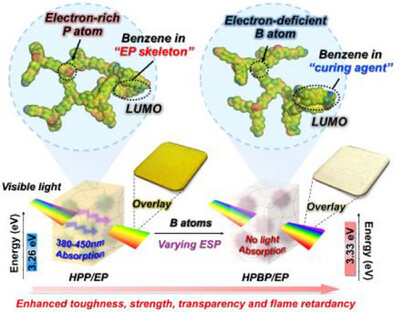
Electron-deficient boron and electron-rich phosphorus are introduced into a hyperbranched polymer to regulate the topology and electronic properties of epoxy resin. This strategy minimizes light scattering and widens the HOMO-LUMO energy gap to suppress visible light absorption, achieving colorless transparent hyperbranched polyborophosphate/epoxy resin (HPBP/EP) material. Dual dynamic B─O and P─O linkages also enhance its strength, toughness, and flame retardancy.
Single-Atom Ir Reserved in Lower Oxidation State by Divalent Iron for Efficient Alkaline Water Oxidation
- First Published: 08 May 2025
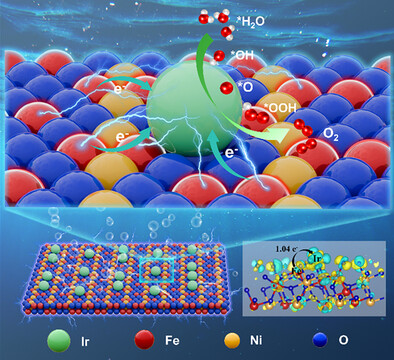
Herein, single-atom Ir is dispersed on the FeNi-based spinel support with sea urchin-like hierarchical nanostructures. The as-prepared Ir/NiFe2O4 possesses outstanding catalytic activity and durability for OER. It is attributed to the lower oxidation state of Ir, which is reserved by using Fe2+ in the support as an electron reservoir to provide extra electrons for Ir species during the OER process.
Reusable Te-Doped Sn-P-I Catalysts With Anti-Healing P Vacancies and Stable I Sites for Efficient Black Phosphorus Growth
- First Published: 02 May 2025
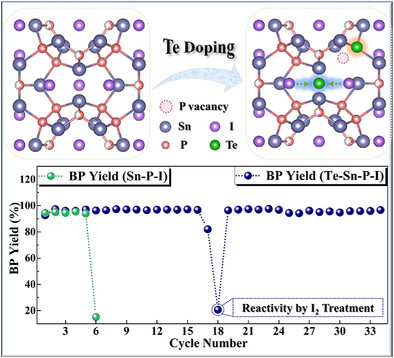
A Te-doped Sn–P–I catalyst featuring anti-healing phosphorus vacancies and stabilized iodine sites is developed for black phosphorus (BP) growth, extending its recyclability from 5 to 17 cycles. Moreover, a simple iodination treatment is shown to fully reactivate the deactivated catalyst. The study also uncovers a synergistic catalytic effect between phosphorus vacancies and iodine during the BP growth process.
Alkylammonium Salt as Additives to Expand the Processing Window of Wide-Bandgap Perovskite Solar Cells Made in Ambient Air
- First Published: 25 April 2025
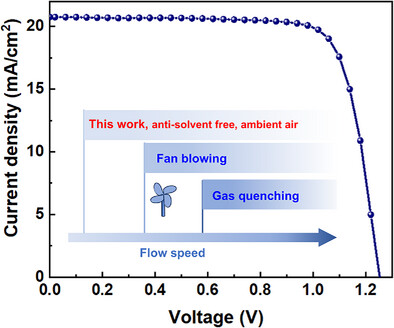
A synergistic alkylammonium salt additives strategy is developed, enabling the preparation of perovskite films with mild gas-flow (≈2.7 m s−1) in ambient air, yielding an efficiency of 19.72% in wide-bandgap perovskite solar cells. This approach reduces flow requirements compared to gas-quenching (>26 m s−1) and fan-blowing (≈5 m s−1) methods, while enabling a scalable production pathway through anti-solvent elimination.
Chia Seed Polysaccharide-Based Self-Assembled Microencapsulation Enhances Hair Regeneration by Inducing Glycolysis and Autophagy
- First Published: 28 April 2025
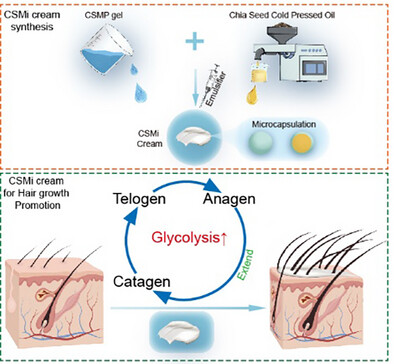
A chia seed–based microencapsulated cream (CSMi) is developed by encapsulating chia seed oil (CSO) with chia seed mucilage polysaccharide-based gel (CSMP). The cream promotes hair regeneration by activating glycolysis and autophagy in hair follicles, facilitating the telogen-to-anagen transition and enhancing the hair growth cycle in a safe and non-invasive manner.
Efficient Electrochemical Hydrogenation of Toluene by Relay Catalysis Over a Ru Single Atom/Nanoparticle Dual-Site Catalyst
- First Published: 08 May 2025
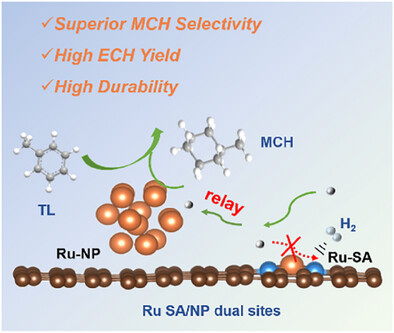
A Ru single-atom/nanoparticle (Ru SA/NP) dual-site electrocatalyst enables efficient electrochemical hydrogenation of toluene to methylcyclohexane (MCH) in acidic media, utilizing protons (H⁺) as the hydrogen source through a relay catalysis mechanism. This system achieves ≈100% MCH selectivity and Faradaic efficiency within a broad potential window of −0.2 to −0.7 V vs. RHE.
Boosting Oxygen Electrocatalysis in CoN-CoSe2 Heterogeneous Hollow Nanocages with Engineered Build-In Electric Field for Zn–Air Batteries
- First Published: 25 April 2025
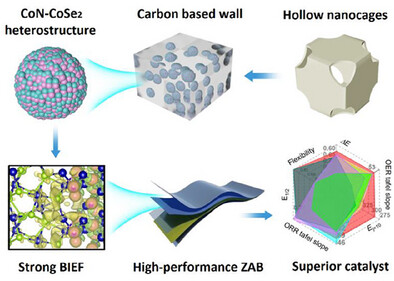
In this work, the CoN-CoSe2@C hollow cages with a built-in electric field (BIEF) on heterointerface are explored as oxygen electrocatalysts for Zn–air battery. Taking the advantage of both the strong BIEF and the well-designed framework, it achieves superior bifunctional electrocatalytic behaviors and good cycling performance even down to low-temperature such as −30 °C.
Wearable SERS-Microfluidic Patch for Real-Time in Situ Monitoring of Chiral Metabolites in Sweat
- First Published: 28 April 2025
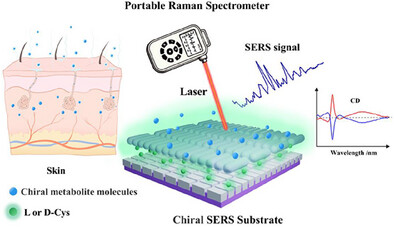
A wearable microfluidic patch is developed that integrates chiral 3D plasmonic nanostructures with SERS activity for real-time, in situ monitoring of sweat metabolism. Using this patch, continuous on-body monitoring of chiral metabolites and pH in human sweat is successfully achieved. This platform holds great potential for personalized health monitoring through dynamic metabolic profiling.
Hierarchically Tailored Porous Carbon via Precursor Engineering for Dual-Redox Electrochemical Capacitors with Record-High Energy Density
- First Published: 28 April 2025
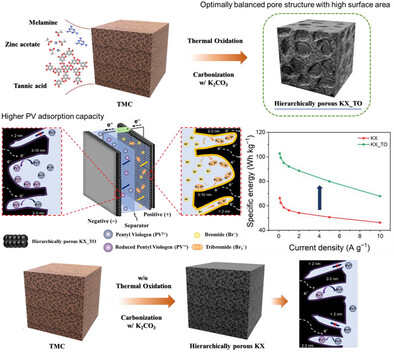
Hierarchically porous carbon with abundant micro- and mesopores is synthesized by a streamlined approach using activation of an oxidized tannic acid-based composite, achieving a remarkable energy density of 125 Wh kg−1 in a redox-enhanced electrochemical capacitor utilizing pentyl viologen (PV) and bromide. The tailored pore architecture significantly enhanced PV redox behavior, highlighting its potential for advanced energy storage applications.
Sulfide All-Solid-State Battery with Ultrahigh Nickel Layered Oxide Cathode and Capacity
- First Published: 05 May 2025
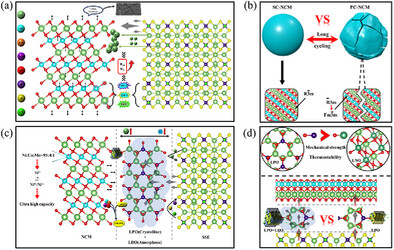
In order to solve the interface problem between the ultrahigh nickel layered oxide cathode and the sulfide electrolyte, a hybrid coating of Li3PO4 (LPO) and Li3BO3 (LBO) is designed on the cathode. With this hybrid coating, the Li+ migration efficiency is improved, which not only effectively suppresses the side reaction but also relieves the stress accumulation of the cathode during long-term cycling and effectively improves the structural stability and mechanical strength of the cathode. The optimized SC-NCM95@LPO+LBO has a high discharge specific capacity of 253.3 mAh g−1 and excellent high-rate performance (83.7% of 1/0.1C) and cycling performance.
Solid-State Photoluminescent Imine-Linked Two-Dimensional Covalent Organic Frameworks
- First Published: 24 April 2025
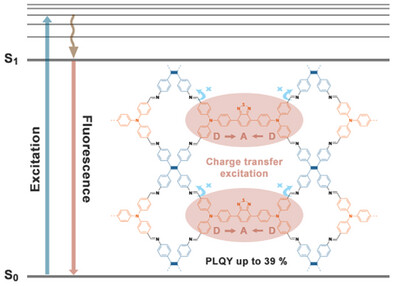
Strategically designed Donor–acceptor–donor structures within covalent organic frameworks (COFs) facilitate efficient charge transfer excitation pathways and suppress the imine bond rotation-induced nonradiative quenching pathways in the excited states, resulting in a photoluminescent quantum yield of up to 39%.
Full-Space Programmable Metasurface for Controlling Both Reflected and Transmitted Waves Under the Same Polarization and in the Same Frequency Band
- First Published: 30 April 2025
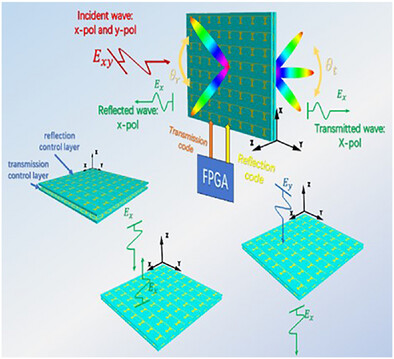
This work provides a novel full-space programmable metasurface that can manipulate the transmitted and reflected EM waves in the same frequency and under the same polarization. By applying different coding strategies, the proposed metasurface can fulfill beamforming, focusing and other applications, showing powerful potential applications in sensing, IoT, and wireless communication systems.
From Magnetoelectric Core–Shell Structure to Compound Eye-Inspired Metamaterials: Multiscale Design of Ultra-Wideband Electromagnetic Wave Absorber Device
- First Published: 25 April 2025
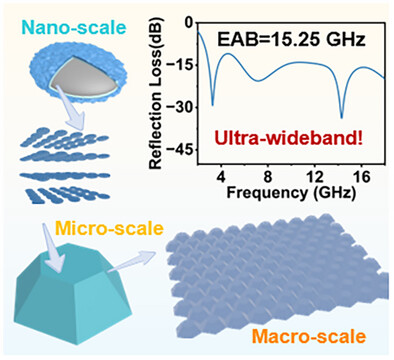
Inspired by arthropod compound eyes, the metamaterial absorber device achieves an ultra-wide effective absorption bandwidth of 15.25 GHz. Its performance is ensured by a multi-scale design, including a 3D macro structure and micro-nano multilayer core–shell structure. This study offers valuable insights for the development of next-generation high-efficiency and intelligent electromagnetic absorption devices.
High-Entropy Engineering of 1D Na4Fe3(PO4)2P2O7: Unlocking Exceptional Capacity and Ultrahigh Rate Capability for Sodium-Ion Battery Cathodes
- First Published: 27 April 2025
Chiral Self-Sorting Directed Supramolecular Organic Framework of Imine Cages for Iodine Capture
- First Published: 02 May 2025
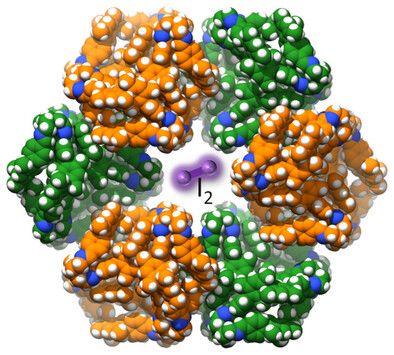
This study presents a supramolecular organic framework constructed via kinetically-controlled and crystallization-driven dynamic covalent chemistry and chiral self-sorting. The framework, stabilized by dispersion interactions among mesitylene groups, forms nanotubular pores that capture iodine with high efficiency from gas-phase, organic, and aqueous environments.
Improving the Performance of Birefringent Crystals by Molecular Assembly Strategy in the Solar-Blind UV Region
- First Published: 05 May 2025
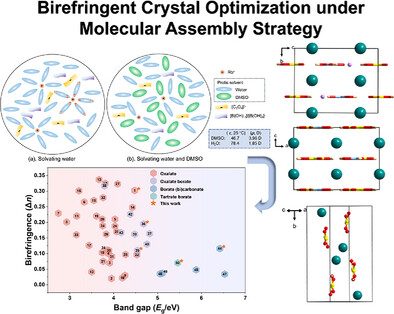
Here, the micro-units that are beneficial to birefringence are selected and modified, and the crystal synthesis process is regulated experimentally by molecular assembly strategy. The successful synthesis of a series of birefringent crystals, all of which exhibit almost the best optical properties in their respective compounds of similar structure, validates the effectiveness of our strategies.




